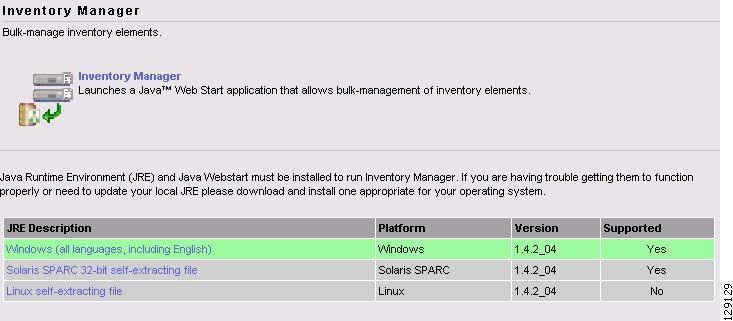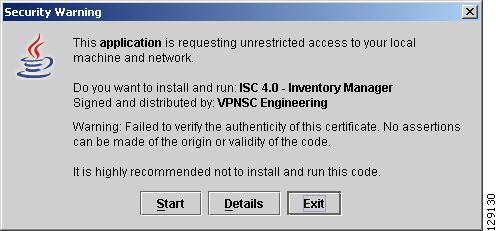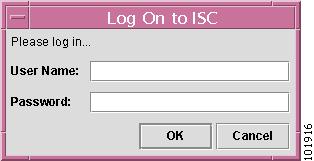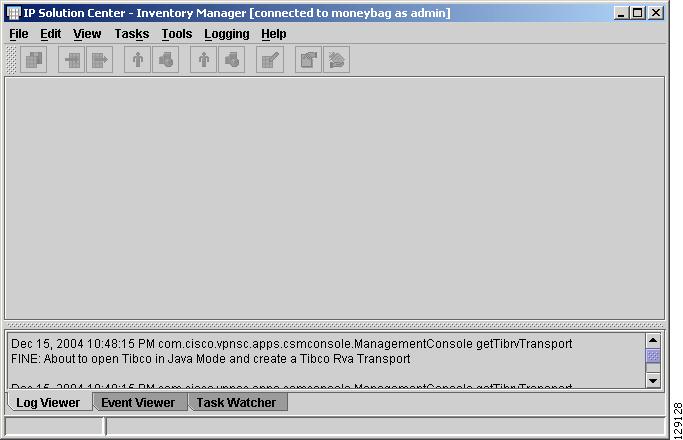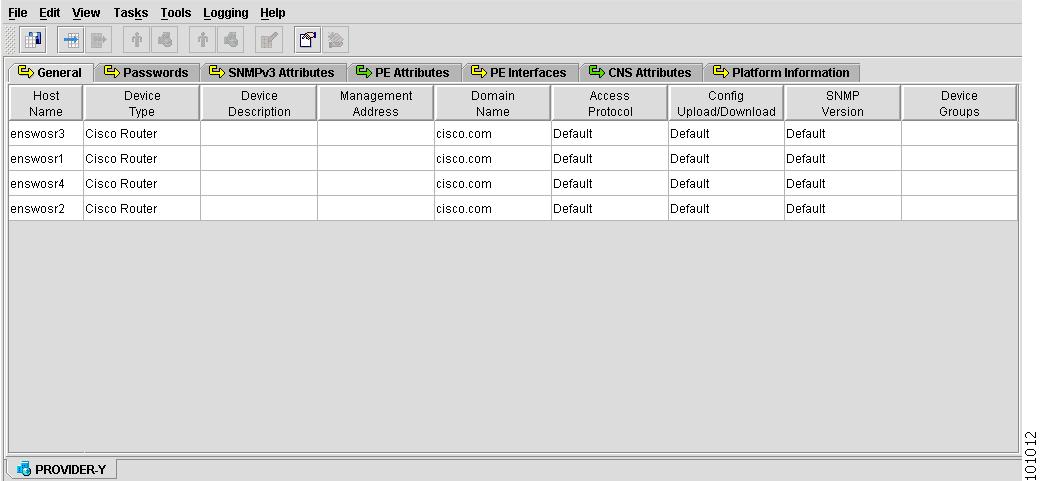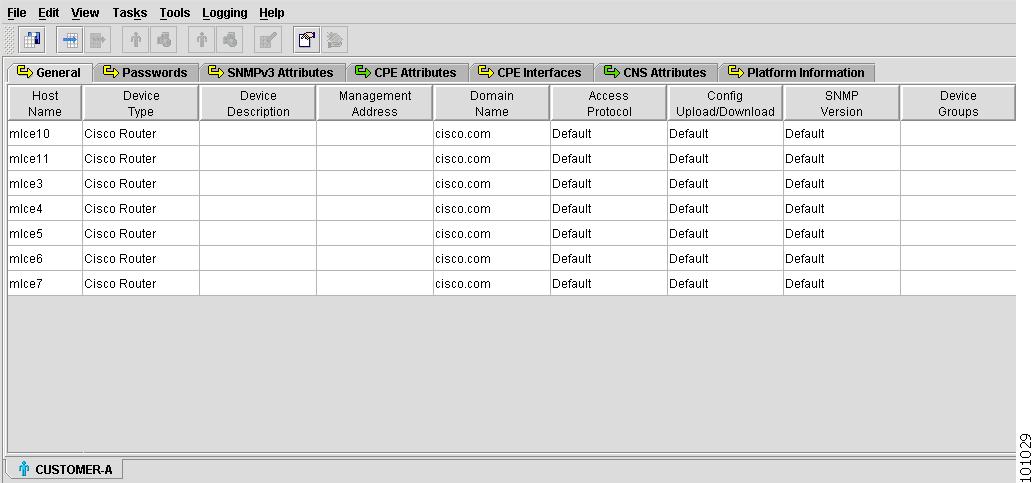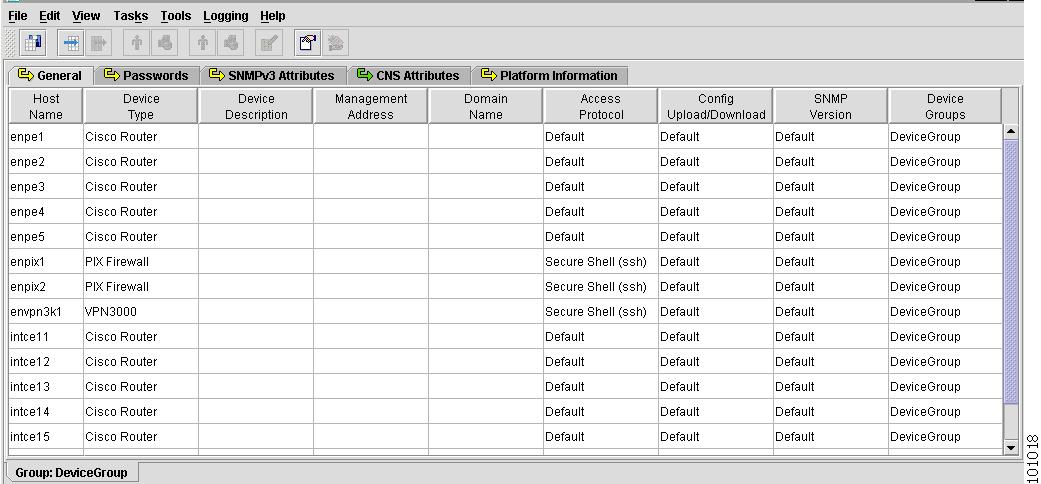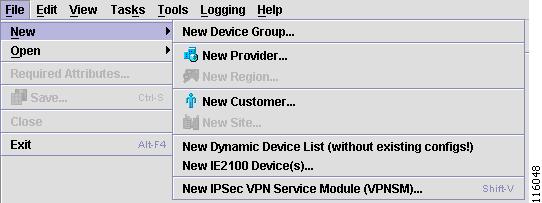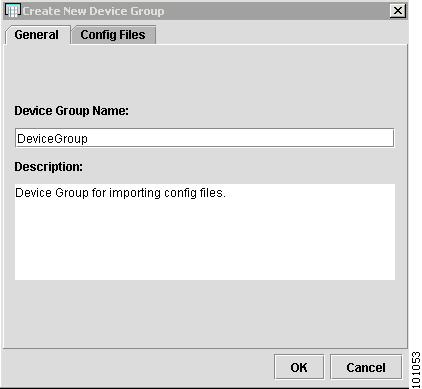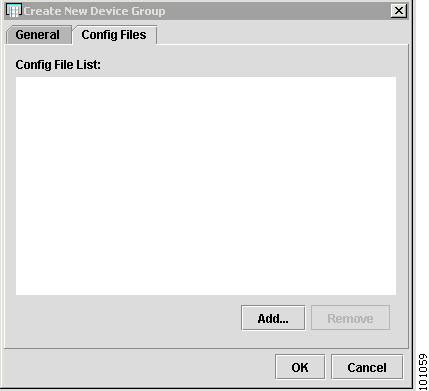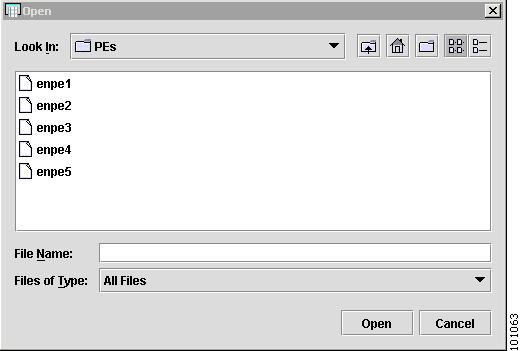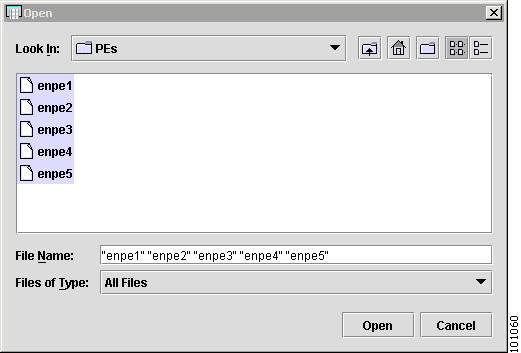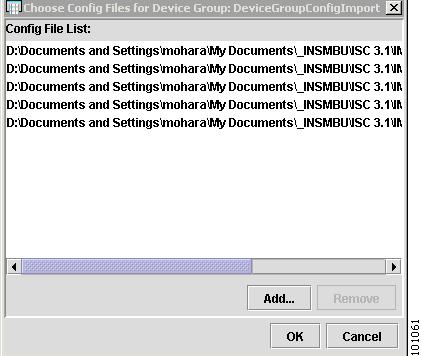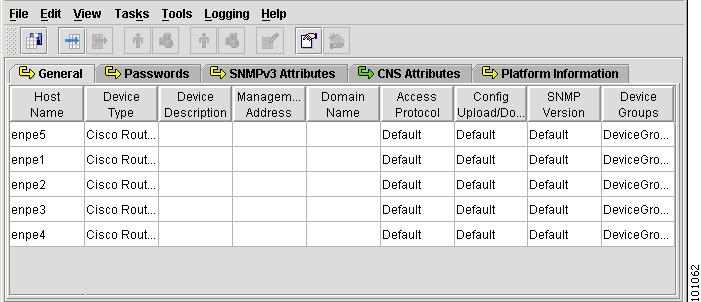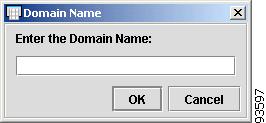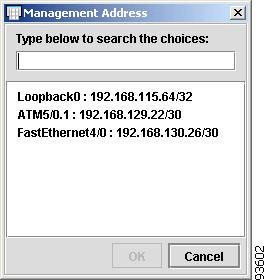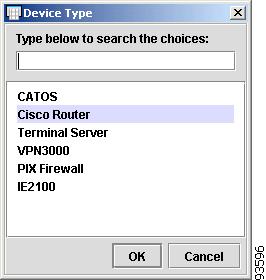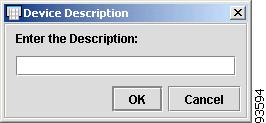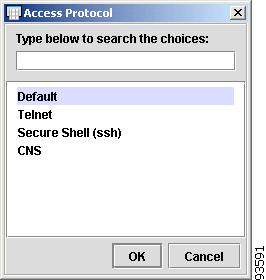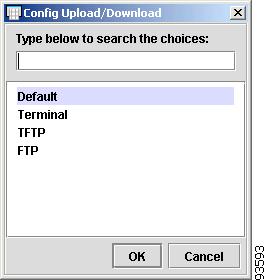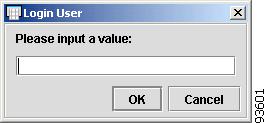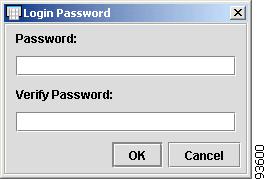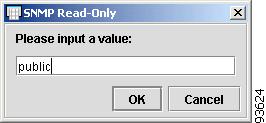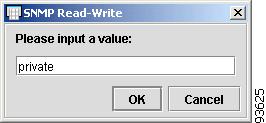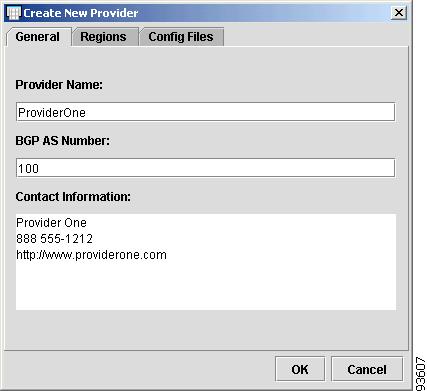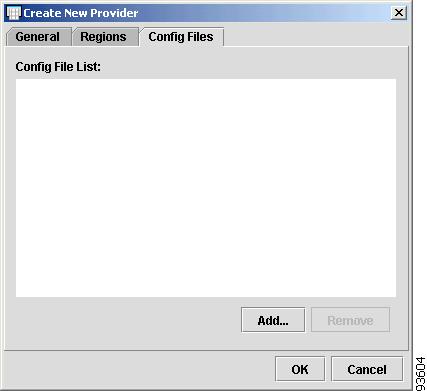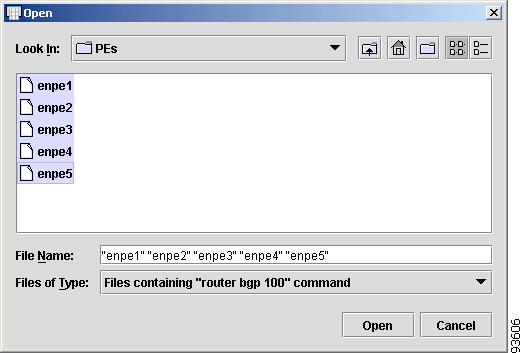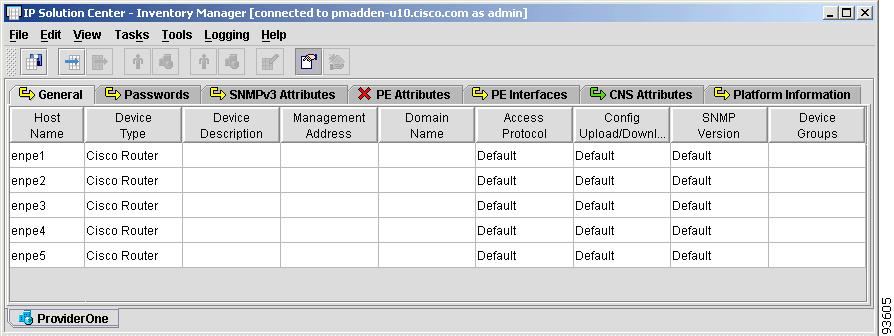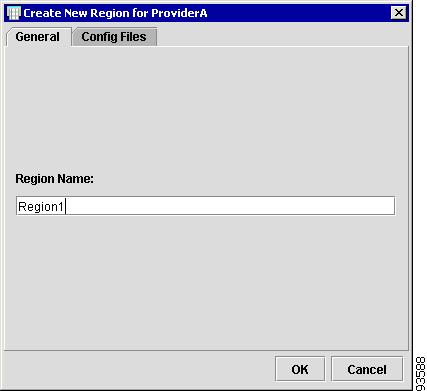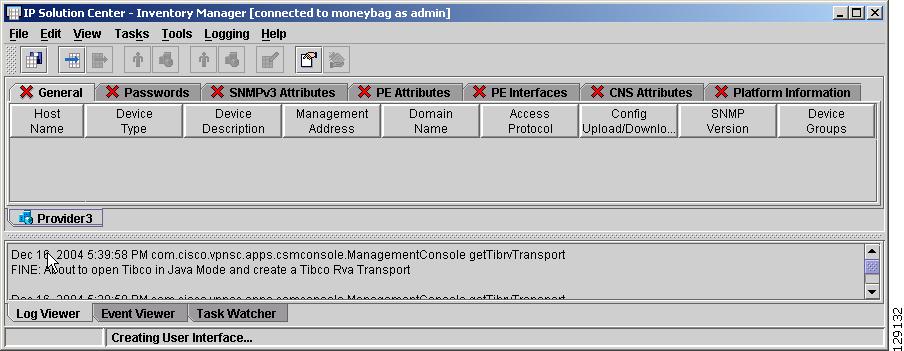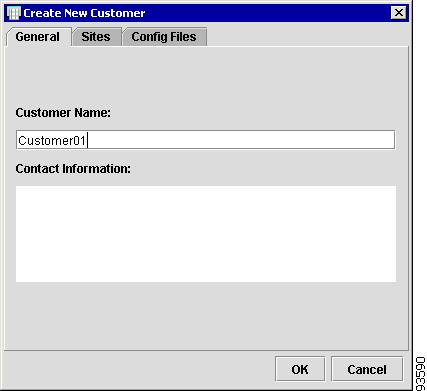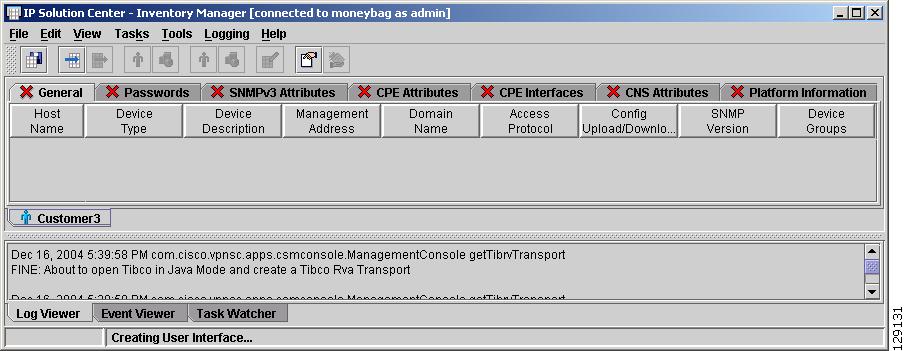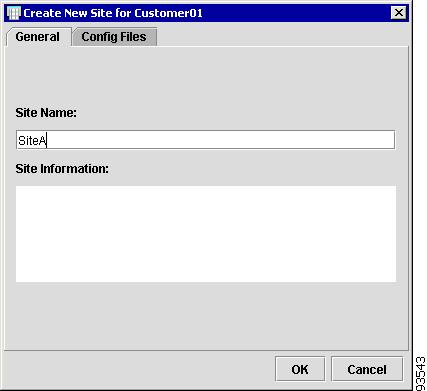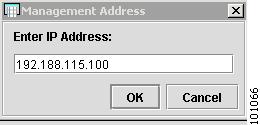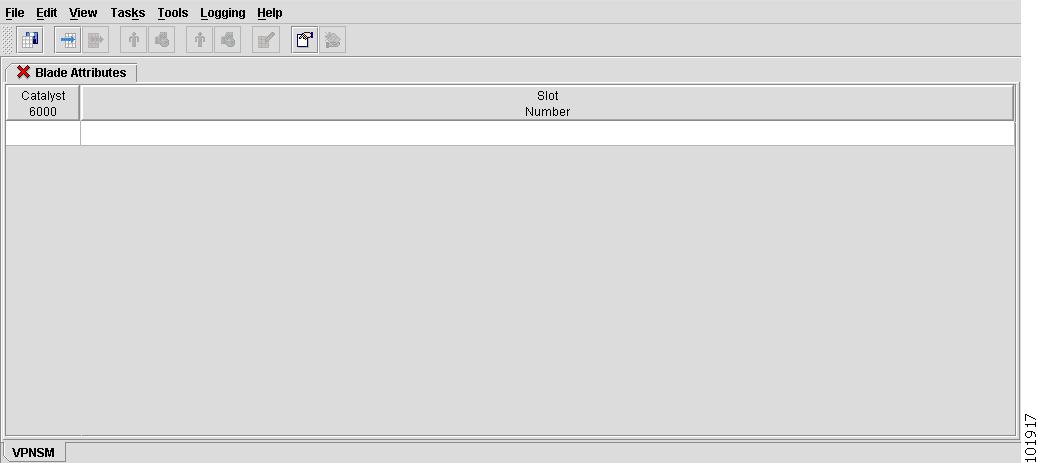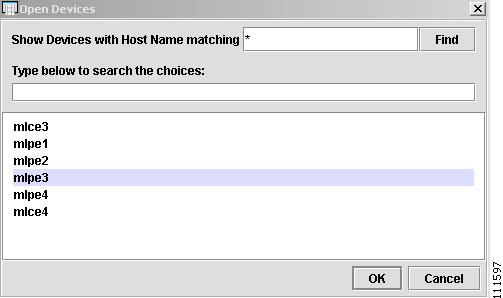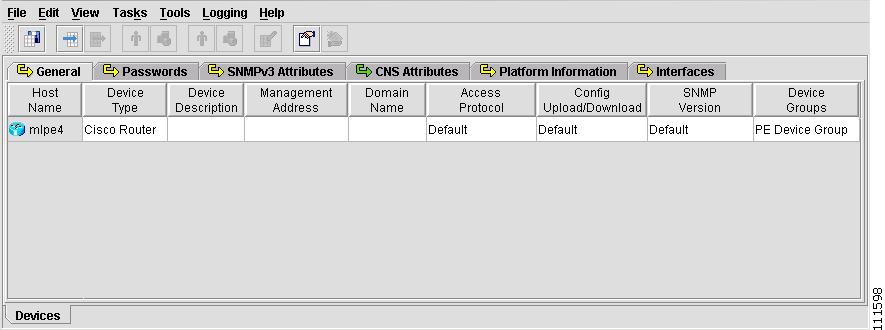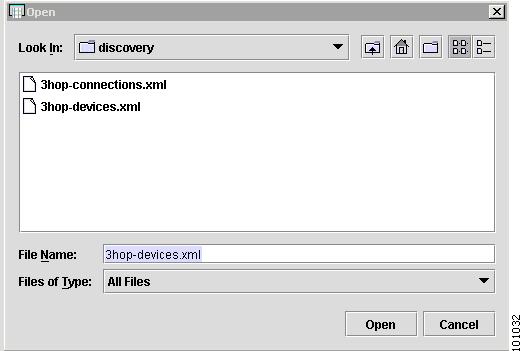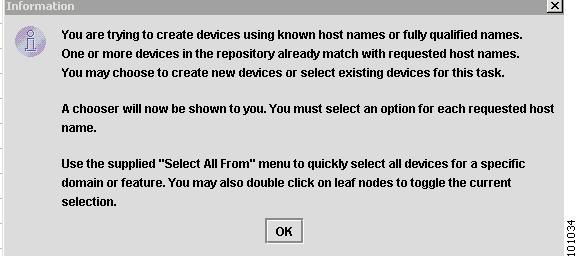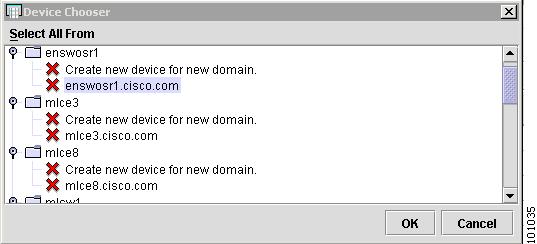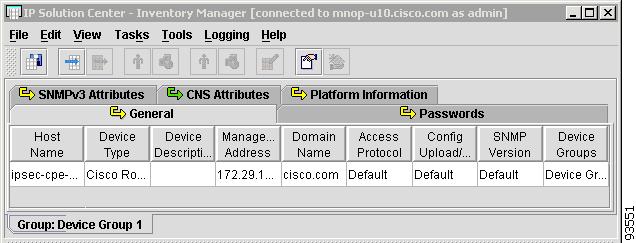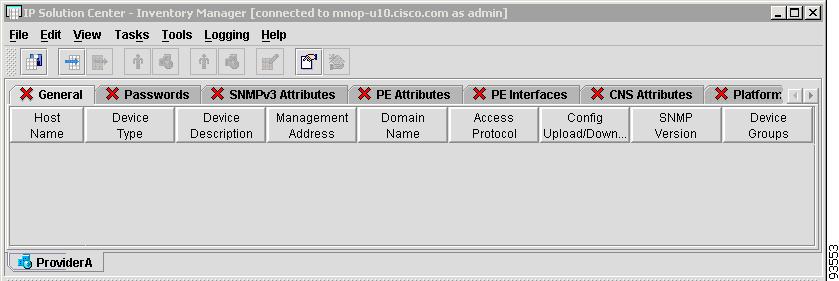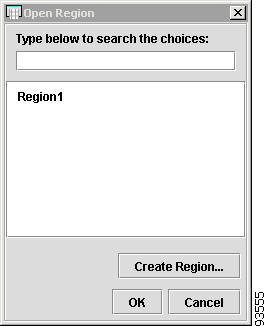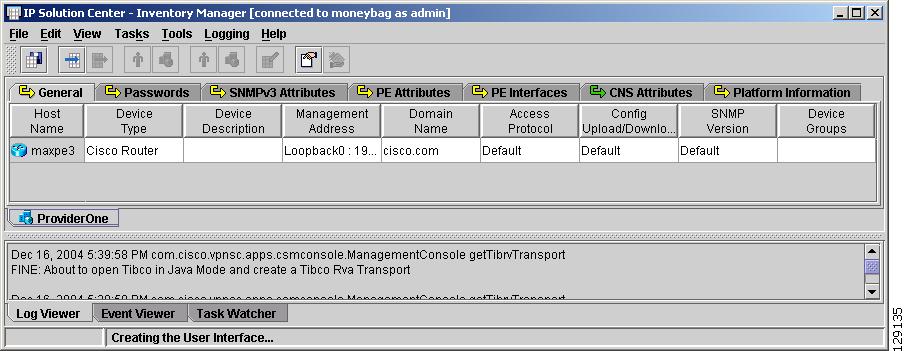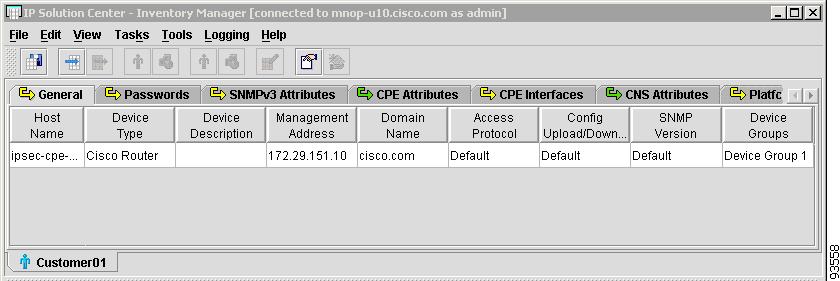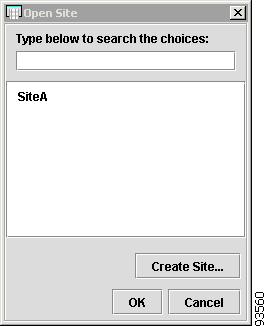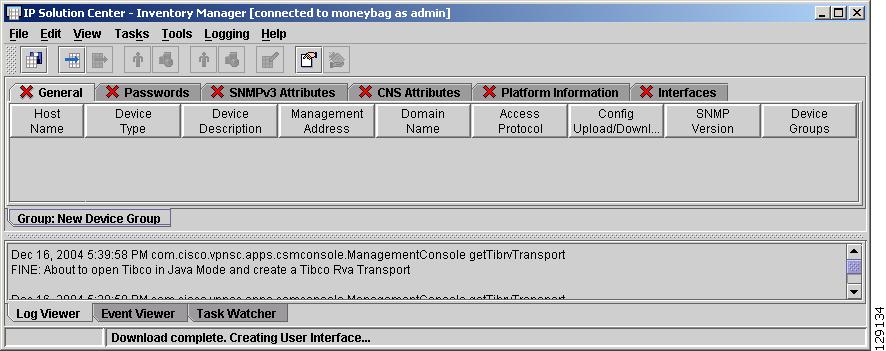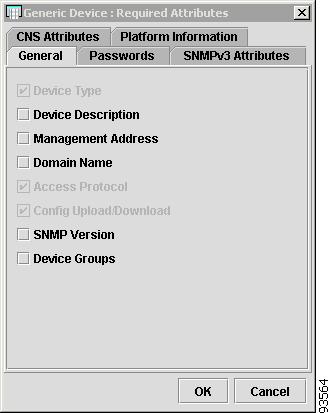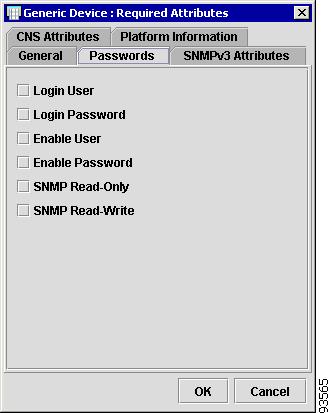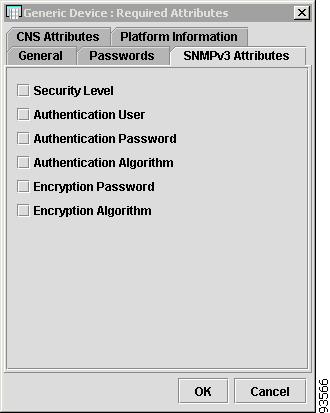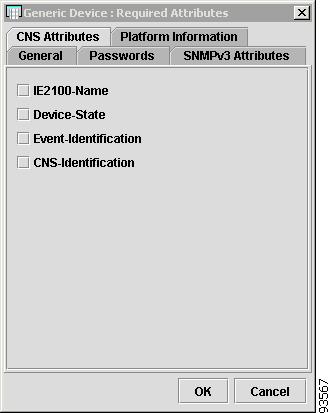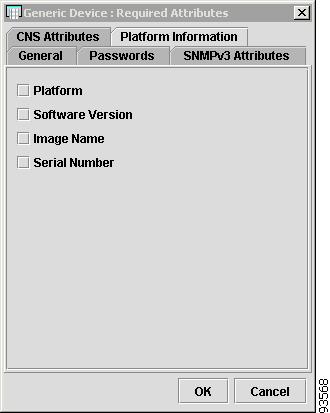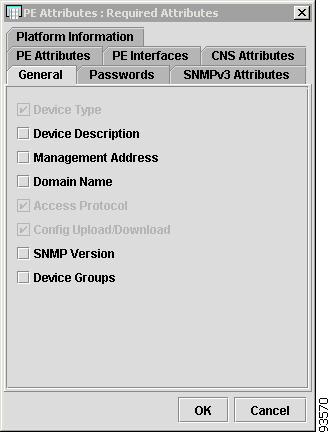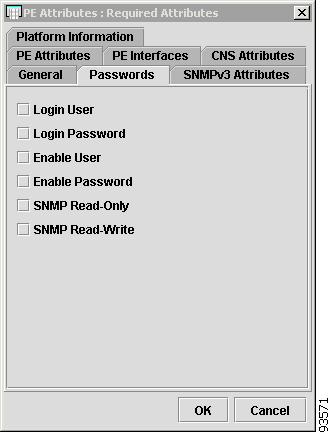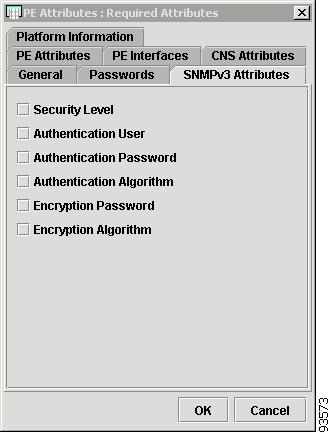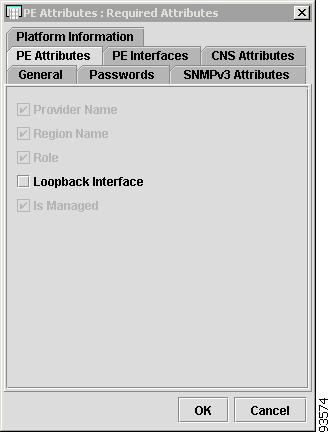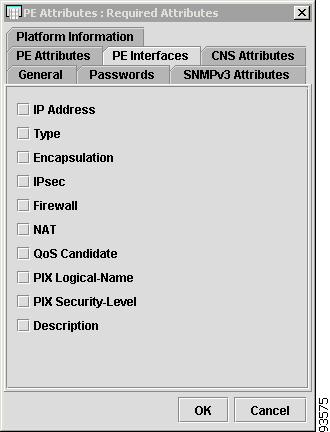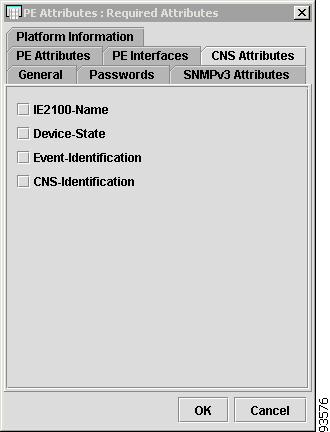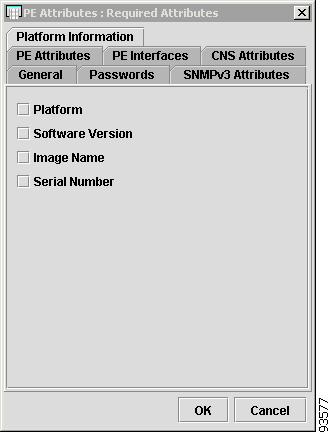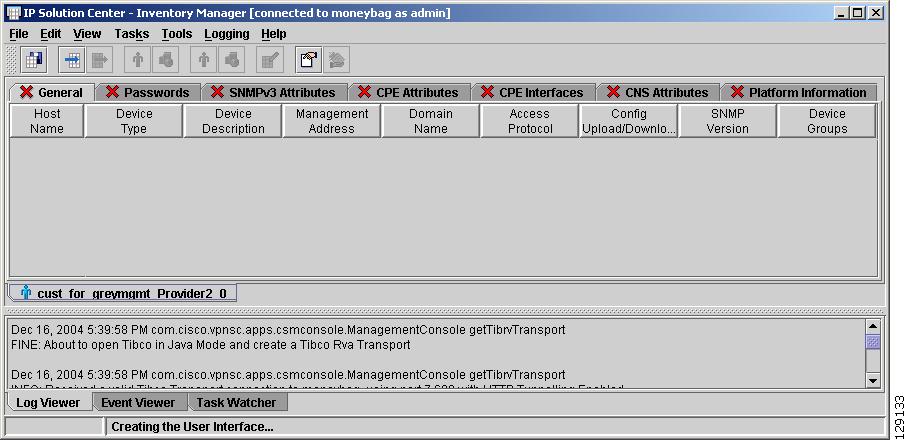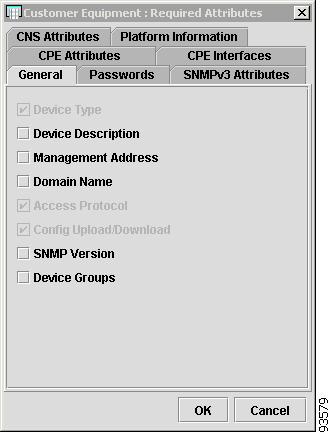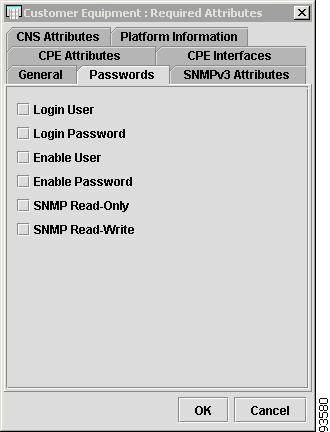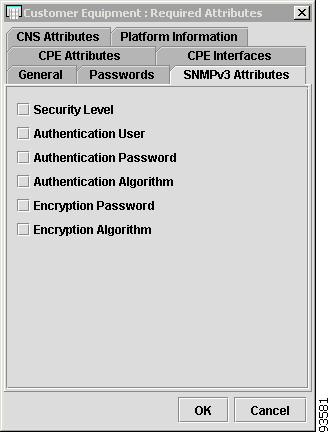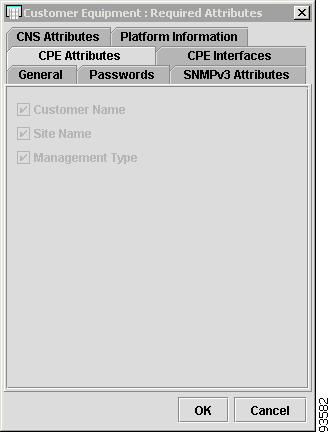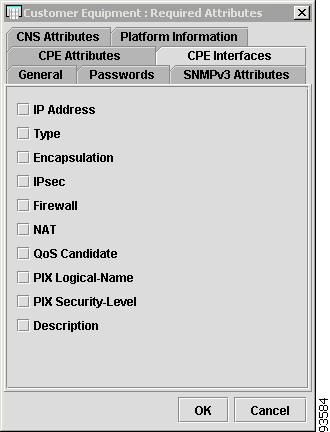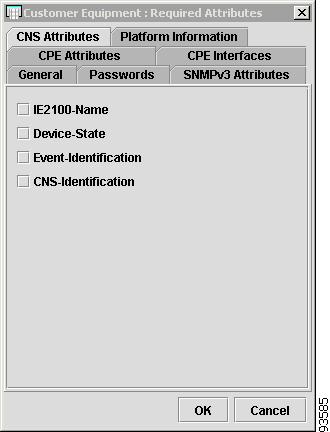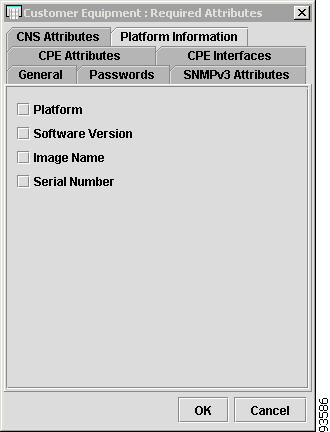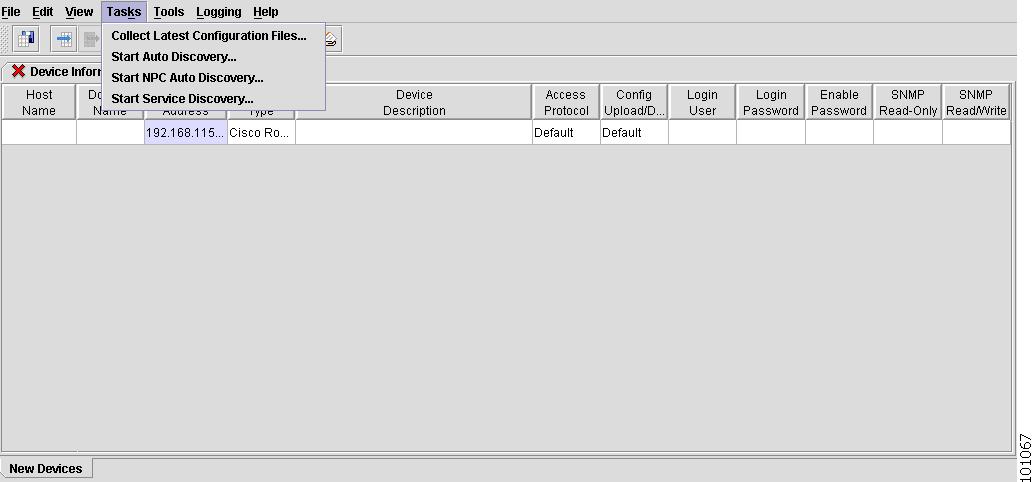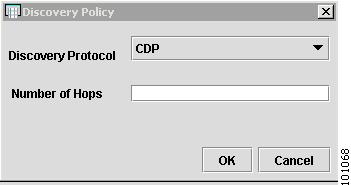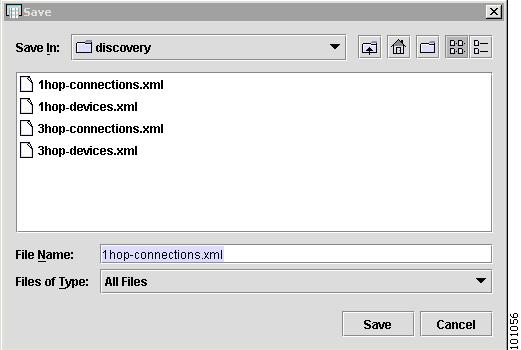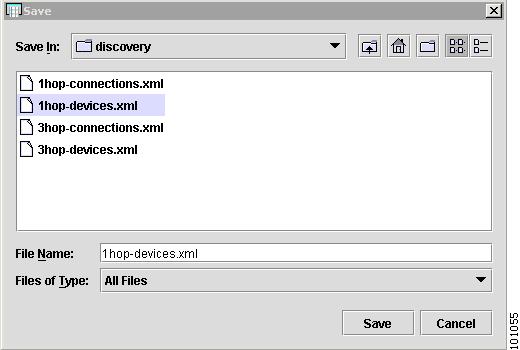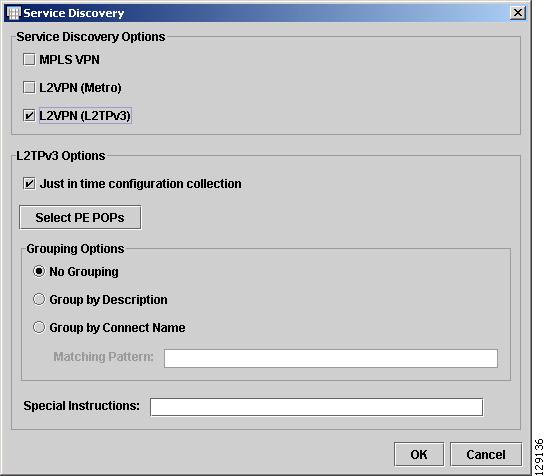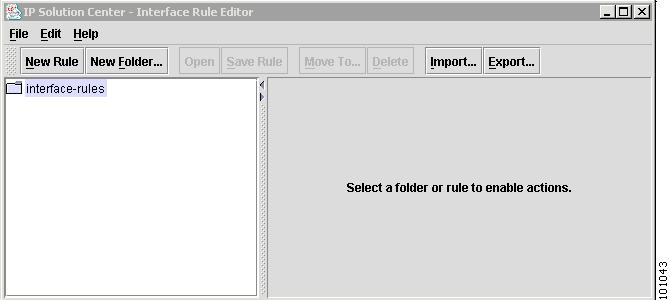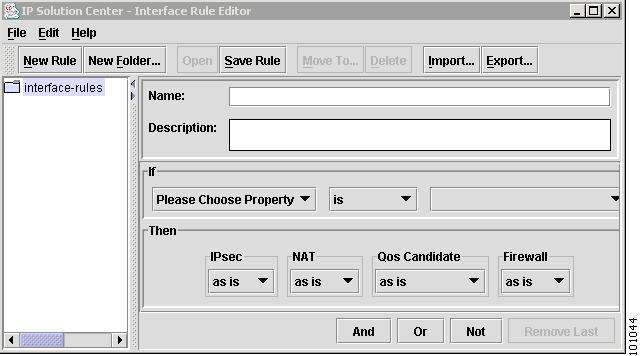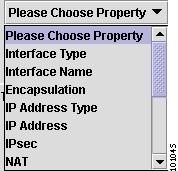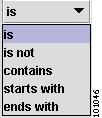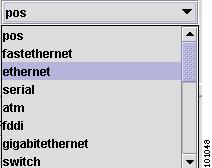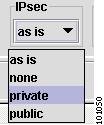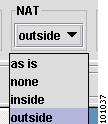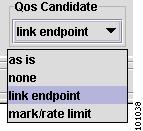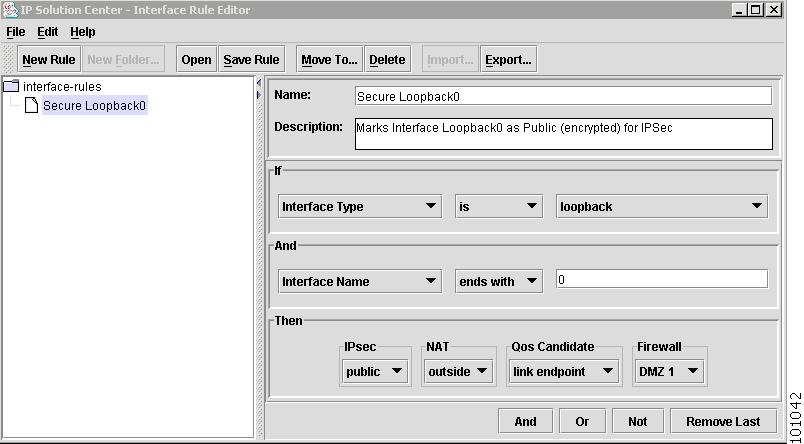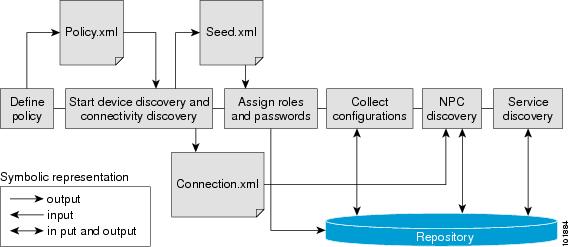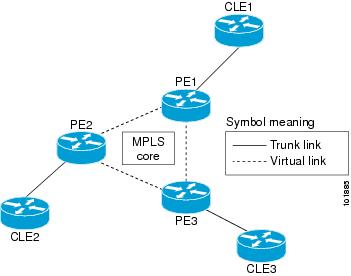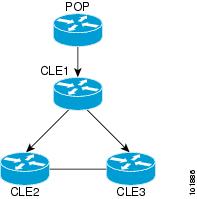

-
Cisco IP Solution Center Infrastructure Reference, 4.0
-
Index
-
About This Guide
-
Getting Started
-
WatchDog Commands
-
Service Inventory > Inventory and Connection Manager
-
Service Inventory > Inventory and Connection Manager > Inventory Manager
-
Service Inventory > Device Console
-
Service Design
-
Monitoring
-
Administration
-
Cisco CNS IE2100 Appliances
-
Property Settings
-
Glossary
-
Table Of Contents
Service Inventory > Inventory and Connection Manager > Inventory Manager
Inventory Manager from End to End
Importing Devices from Configuration Files
Importing Devices with Auto Discovery
Configuring Device Credentials and SNMP Parameters
Collecting Configuration Files
Marking Interfaces for IPsec, Firewall, NAT, or QoS
Creating a New Customer with Devices
Creating a New Provider with Devices
Importing Connections with NPC Auto Discovery
Importing Services with Service Discovery
Introducing the Inventory Manager GUI
Inventory Manager GUI Reference
Load Default Values to Selected Cells
Apply Interface Marking Rules to Selection
Show Color Coded Column Headers
Collect Latest Configuration Files
UNIX Command Line Interface (UNIX CLI)
MPLS Service Discovery Overview
MPLS Service Discovery Process
Ring Topology Discovery (Connection Discovery)
Service Inventory > Inventory and Connection Manager > Inventory Manager
This chapter describes how to use Inventory Manager to prepare service inventory for the IP Solution Center (ISC) provisioning process. It contains the following subsections:
•
Overview of Inventory Manager
•
Prerequisites and Limitations
•
Inventory Manager from End to End
•
Introducing the Inventory Manager GUI
•
Inventory Manager GUI Reference
•
Ring Topology Discovery (Connection Discovery)
Overview of Inventory Manager
Inventory Manager provides a method of managing mass changes to inventory and service model data in the ISC provisioning process. In this process, Inventory Manager enables an operator to import network specific data into the ISC Repository (Repository) in bulk mode.
Inventory Manager performs three primary functions:
•
Imports devices and configures CPE and PE by associating devices with a Customer or Provider.
•
Collects live configuration files from a variety of devices (for example, routers, firewalls, and switches) in a network.
Note
IPsec, firewall, NAT: These features are not supported in this release.
•
Discovers logical, physical, and service level connectivity in a network.
Auto Discovery is an important tool in this process and is invoked from Inventory Manager. It can also be invoked from a Unix command line interface although this method is not recommended (see UNIX Command Line Interface (UNIX CLI)). For a detailed description of Auto Discovery, see Auto Discovery.
Prerequisites and Limitations
This document is intended for network engineers who have sufficient experience with MPLS VPN, L2VPN, and IPsec to provision these technologies using ISC.
Note
IPsec: This feature is not supported in this release.
All of the network elements that you plan to provision should support the required hardware features and Cisco IOS versions.
Client Requirements
Java Runtime Environment (JRE) and Java Web Start must be installed to run Inventory Manager. If you are having trouble getting them to function properly, or need to update your local JRE, you can download and install the version appropriate for your operating system:
•
Windows (all languages, including English): 1.4.2_04
•
Solaris SPARC 32-bit self-extracting file: 1.4.2_04
•
Linux self-extracting file: 1.4.2_04 (Not Supported)
Name Resolution
Inventory Manager requires name resolution. The ISC HTTP server host must be in the Domain Name System (DNS) that the web client is using or the name and address of the ISC server must be in the client host file.
SNMP
Prior to device discovery, SNMP must be enabled. All devices in the ISC provisioning environment must support SNMP. ISC supports SNMP versions 1, 2c, and 3.
CDP
CDP must be enabled to discover devices. Inventory Manager uses CDP to perform the service discovery task. CDP should be enabled globally and at the interface level for each device in the ISC provisioning environment.
NAT
This feature is not supported in this release.
Prior to device discovery, no Network Address Translation (NAT) mapping for router IP addresses is allowed.
Role Requirements
To run the Inventory Manager you need to use the predefined roles, CollectionRole and DeviceImportRole. This is the minimum requirement to successfully create physical or logical devices and to upload configuration files from the client to the ISC server.
Inventory Manager from End to End
This section describes how you use Inventory Manager to import and configure devices, collect configuration files, and perform service discovery.
These tasks should be carried out in the following order:
1.
Launching Inventory Manager
–
Importing Devices from Configuration Files
–
Importing Devices with Auto Discovery
3.
Configuring Device Credentials and SNMP Parameters
4.
Collecting Configuration Files
5.
Marking Interfaces for IPsec, Firewall, NAT, or QoS
6.
Creating a New Customer with Devices
7.
Creating a New Provider with Devices
8.
Importing Connections with NPC Auto Discovery
9.
Importing Services with Service Discovery
Launching Inventory Manager
To launch Inventory Manager, follow these steps:
Step 1
Log in to ISC.
Step 2
Navigate Service Inventory > Inventory and Connection Manager > Inventory Manager and you receive a window, as shown in Figure 4-1, "Inventory Manager." If you choose or need to click on an installation of Java Runtime Environment (JRE) for an operating system, follow that path, then quit the browser, log in again, and navigate the path in this step again.
Figure 4-1 Inventory Manager
Step 3
Click Inventory Manager in Figure 4-1, "Inventory Manager" to launch Inventory Manager on the web client. The Java Web Start window appears.
Step 4
From the Security Warning window, click Start to automatically complete the configuration, as shown in Figure 4-2.
Figure 4-2 Start Java Web Start
Step 5
You receive a login window, as shown in Figure 4-3, "Log On to ISC."
Figure 4-3 Log On to ISC
Step 6
Enter your User Name and Password and click OK.Inventory Manager launches and connects to the Master ISC server.
The Inventory Manager Opening Screen in Figure 4-4 appears.
Figure 4-4 Inventory Manager Opening Screen
Importing Devices
As described in the introduction to this chapter, devices can either be imported or created. The fastest way to bring device information into the Repository is to import devices using Inventory Manager.
Importing Devices from Configuration Files
If the configuration files are for a particular customer or provider, you can create a new customer or provider and associate the configuration files with CPEs or PEs. If the customer or provider currently exists in the Repository, you can open them and insert more CPEs or PEs to be associated with new or existing sites or regions.
To import devices with configuration files, follow these steps:
Step 1
From Inventory Manager, choose File > New > New Device Group.
This step creates a container for target devices that can be moved to a provider or customer during the initialization process.
Step 2
Enter a device group name and click OK.
You receive a prompt to import configuration files. You probably have a repository of configuration files on an existing network management device or TFTP server. Copy these files to the web client machine for import or make them available with a shared directory.
Step 3
At the No Config Files Specified for Import prompt, click Yes.
The configuration files on the web client can be located by normal file browsing with both Shift and Ctrl+Click selected for multiple selections. When creating a new device group, only one filtering option is available: All Files.
Note
When creating new Providers, there are filters for files containing a specific BGP autonomous system number, or files that do not contain BGP configuration. The BGP filters can also be used to select PE devices that must have BGP configured or CE devices that do not require BGP.
Step 4
At the Open dialog box, browse to the location of the configuration files you want to import.
You may select multiple configuration files to import using SHIFT or CTRL + click. Please make sure that no more than X (250 or a number to be determined) configuration files are selected for import. There may be performance issues with Inventory Manager if more than X config files are selected for import at once.
Inventory Manager now imports a row in a spreadsheet workbook for each selected configuration file. By default, Inventory Manager inspects the configuration files and determines the device type, which includes Cisco IOS, CatOS, PIX, and VPN 3000 (IPsec, firewall, NAT, VPN 3000: These features are not supported in this release). It also parses passwords, SNMP information, interfaces, and virtual circuits.
If cells in the resulting spreadsheet are empty, Inventory Manager was not able to determine the value and, if it is required, the operator must provide the data or choose the information from a defined set of choices before saving.
These operations are described in more detail in the following sections as they are common to all methods of importing device information and administration.
Step 5
Once the appropriate files are selected, click Open, then click OK.
Importing Devices with Auto Discovery
Note
The Auto Discovery process can either be activated from Inventory Manager or from the command line on the ISC server using the Cisco Cornerstone Bridge Auto Discovery scripts.
To import devices with Auto Discovery, follow these steps:
Step 1
From Inventory Manager, select File > New > New Dynamic Device List.
This creates a spreadsheet where each row represents a potential seed device for discovery. For each seed device, the management interface must be provided. The management interface is the address on the device that the ISC host uses to reach the device.
After creating a new device list, a discovery starting point needs to be configured. This starting point is a device that can be reached from the ISC host. For each seed device, an accessible interface on the starting point is configured, because the management interface must be provided. The management interface is the address on the device that the ISC host uses to reach the device.
New dynamic device discovery requires the following manual tasks:
•
Entering a seed IP address
•
Entering a maximum hop count on the initialization of the task
A policy.xml file is created and a hop count is set automatically.
To choose the seed devices and hub, pick a seed device that can reach a large section of the network. Pick one or more of them until you think these devices will enable you to reach your entire managed network.
Point-of-presence (POP) routers are usually good choices. If you choose all the POPs in your network as the collection of seed devices and put in the appropriate number of hubs, you discover the entire managed network.
To pick the hub number, go to the CE that is the furthest from its associated POP, and count the number of devices between them. If this number is N, the hub number is N+1, assuming you are picking the POP as the seed.
Step 2
Click on the Management Address cell and enter the seed IP address for the new dynamic device list
Step 3
Choose Tasks > Start Auto Discovery.
A maximum hop count is specified for the Auto Discovery process. The Auto Discovery process queries the starting point device for its CDP table. From this table, all of those devices are queried for their CDP information. This CDP query process continues until the maximum hop count from the starting point is reached. Please note that only devices running the CDP process are discovered.
Step 4
Specify the maximum hop count when you receive the prompt.
Note
Only devices running the CDP process are discovered.
You are prompted to save two files. One file contains the list of the discovered devices and the other contains information related to connectivity between the devices. The discovered device information can be saved in XML to use as a starting point for future discovery efforts.
Step 5
Save the devices discovery.
Step 6
To view the Auto Discovery logs, go to Administration > Control Center > Hosts > machine-name > cornerstone bridge.
Configuring Device Credentials and SNMP Parameters
After the discovered devices are rendered in the spreadsheet, they must have several parameters set before the devices can be saved to the Repository and perform a successful live configuration collection. These parameters include:
•
SNMP read and write community strings
•
Telnet login password
•
Device enable password
Note
The reachable management address is usually Loopback 0.
First remove any devices that are not required in the provisioning process. These items include core network devices or non-PE, CPE, and CLE devices that are used within the operator's network.
To remove unwanted devices, follow these steps:
Step 1
Select the rows for the devices to be deleted.
Shift-select and Control-select are useful for multiple devices.
Step 2
Choose Edit > Remove Selected Devices.
It is common in networks for devices to share many parameters. The Defaults option allows these common parameters to be entered for many devices at the same time; for example, login password, enable password, and SNMP strings.
To edit multiple devices, follow these steps:
Step 1
Choose Edit > Edit Default Attributes.
A row for default values can be edited for each tab of the device list. The next step of the configuration process collects live configurations that require login and enable passwords.
Step 2
Enter login and enable passwords into the defaults row.
After entering the default values, select all of the devices that share those common parameters. For devices that have values other than the default values, you can perform multiple editing techniques.
Step 3
Select multiple rows or columns using standard selection techniques and choose Edit > Edit Selected Devices.
A dialog box, similar to the defaults window appears, allowing you to enter values to be applied to the selection.
Note
You can right click on the column name and a menu appears showing you choices for sorting and selecting or de-selecting of columns.
Step 4
To configure these devices, choose Load Default Attributes to Selected Cells.
The management IP address is the address that ISC uses to communicate with the element. This address must be reachable from the ISC host. When the devices were imported or discovered, ISC attempts to select the proper address as a management address starting with a loopback address. Verify the selected address for accessibility from the ISC host. ISC must be able to reach the network element for the configuration process to progress.
Step 5
Click on the Management Address cell and enter the IP address in the dialog box.
Collecting Configuration Files
Collecting configuration files serves two purposes. It loads the current configuration information for the device, which populates many of the cells. It also verifies reachability and passwords for the reachable devices.
This task is created in the Repository and starts immediately. Logs can be viewed as normal for a collection spawned using only the Web GUI.
The task name is Inventory_Manager_Collection_xxxxxx_username, where xxxxxx is a unique number and the username is admin, or whatever the logged in username is in ISC.
To collect configurations, follow these steps:
Step 1
Select all the devices that have valid passwords and could be reached.
Step 2
Choose Tasks > Collect Latest Configuration Files.
Marking Interfaces for IPsec, Firewall, NAT, or QoS
IPsec, firewall, NAT: These features are not supported in this release
The interface marking process is only required for provisioning IPsec, Firewall, NAT, or QoS services. Marking interfaces on a one-by-one basis can be a very time consuming and tedious task. Inventory Manager provides a helpful tool to create rules for marking interfaces based on predefined criteria. You can apply one or more rules to selected devices to mark the interfaces in a bulk fashion.
For IPsec, the public interfaces are the interfaces where the IPsec or GRE tunnels terminate and the private interfaces are the interfaces behind which the subnets to be protected reside.
For firewalls, the outside interfaces connect to the outside, typically unsecured, networks and the inside interfaces are for the subnets residing behind the firewall.
To mark interfaces with Inventory Manager, follow these steps:
Step 1
Choose Tools > Interface Rule Marking Editor.
A window appears allowing you to create, modify, or delete existing rules or folders. One simple rule can mark all Loopback0 interfaces as public for IPsec.
Step 2
To apply a rule to one or more devices, select the device(s) in the spreadsheet.
Step 3
Choose Edit > Apply Interface Marking Rule(s) to the selection. A rule chooser appears allowing you to select one or more rules to be applied.
Note
After completing the device configuration process, all the red X marks on the Device List tabs should be converted to either yellow or green Check Marks. These marks indicate that you have completed the required configuration and can save the device list, provider, and/or customer. Save all the completed lists by selecting Save under the file menu. Now all the device preparation should be complete and provisioning setup can begin.
Creating a New Customer with Devices
The devices should now be assigned roles, either PE or CE. For customers, you can assign roles by highlighting each device group and adding it to a new or existing Customer. Routers can be moved in bulk to customers with Inventory Manager.
To move CE routers to a new customer, follow these steps:
Step 1
Select the desired routers and choose Edit > Move to New Customer.
Step 2
You are prompted to enter a customer name.
Step 3
Enter a customer name and click OK.
A new tab is created at the bottom of the device list and the routers are associated with the customer.
Each customer router must be put into a site. A site can have more than one router in it. All routers in a site should share routing information with the external provider network.
Step 4
Shift-select the Site Name cells for each customer router in the CPE Attributes tab.
Step 5
Choose Edit Selected Devices.
Step 6
Choose CUSTOMER_ID+"SITE"+HOST_NAME.
Repeat this process for all the CPEs.
All customer routers must have a Management Type selected. As with customer site, a range of router Management Type cells can be selected for bulk editing.
Step 7
Click the Management Type cell for all CEs.
Step 8
Choose Edit Selected Devices.
Step 9
Select the Management Type.
Creating a New Provider with Devices
A provider or provider administrative domain (PAD) is a group of Provider Edge (PE) devices that share a common BGP AS.
To move PE routers to a new provider and create a region, follow these steps:
Step 1
Highlight the devices with a common BGP AS to be added to a new provider.
Step 2
Choose Edit > Move to New Provider.
When the devices are assigned a PAD, they become Provider Edge (PE) routers. PEs must be placed into regions. Each PAD must have one or more regions. A region is a collection of PEs that may share an address pool.
Step 3
To place a PE into a region, click on the Region cell for the PE.
If the desired region has already been created, it can be selected.
Step 4
Choose Create Region to add a region.
You can also add multiple PEs to a single region in one step using standard multiple selection techniques and choosing the Edit > Edit Selected Devices menu. As with single PE editing, you are prompted to choose an existing region or create a new region.
This completes the assignment of roles to devices.
Note
The tabs at the top of the device list pane of the Inventory Manager window corresponds to a grouping of information about the devices. The symbol to the left of the tab name indicates whether all the information required on that tab has been configured. A red X means that additional information is required. A yellow check mark indicates that all required information has been entered but not all possible information. A green check mark shows that all information for that tab has been entered. To save the devices to the Repository, each tab must show a check mark of green or yellow.
Importing Connections with NPC Auto Discovery
To discover connections, referred to as Named Physical Circuits (NPC), run NPC Auto Discovery. This task defines the PE and CE link information, which is used by Common Discovery in the final stage of the Auto Discovery process. NPC Auto Discovery has one prerequisite, the connection.xml file. Ensure that this file has been uploaded from the ISC server to the client workstation before running this task.
To import connections with NPC Auto Discovery, follow these steps:
Step 1
Choose Tasks > Start NPC Auto Discovery.
You are prompted to provide the path to the correct connection.xml file.
Step 2
Select the correct connection.xml file and click OK.
A dialog box appears, indicating that the NPC discovery process has started.
Step 3
You are prompted if the task completes successfully. Select OK to finish this portion of the NPC Auto Discovery process.
To find the discovered NPCs, go to Service Inventory > Inventory and Connection Manager > Named Physical Circuits.
Importing Services with Service Discovery
At this point, you can choose to run the Common Discovery process. ISC manages Ethernet over MPLS (L2VPN) and MPLS networks with IPsec (IPsec: This feature is not supported in this release). To detect free interfaces on each device for provisioning purposes, existing services either need to be discovered automatically or entered into the system manually.
For very large networks with many provisioned services, manual entry is time consuming and prone to human error. These issues are alleviated by the Common Discovery process. The Common Discovery process discovers:
•
Layer 3 MPLS VPN services
•
Layer 2 VPN (Metro) services
•
Layer 2 VPN (L2TPv3) services.
To specifically import services with Auto Discovery, follow these steps:
Step 1
Choose Tasks > Start Service Discovery.
The Service Discovery window in Figure 4-112 appears (see Start Service Discovery, for the GUI description). You are prompted to select which type of Common Discovery to perform.
Step 2
Select one or more types of service discovery by checking the corresponding Service Discovery box.
If you select L2VPN (L2TPv3), the bottom L2TPv3 Options section become available:
Step 3
Make the desired selections
You are notified when Service Discovery is finished.
Step 4
To find the discovered service requests, go to Service Inventory > Inventory and Connection Manager > Service Requests.
Introducing the Inventory Manager GUI
Although Inventory Manager has the physical look and feel of many windows applications, with File, Edit, View, Tasks, Tools, Logging, and Help menus, the application is designed to have the logical view of a spreadsheet. When you learn how to use one spreadsheet in Inventory Manager, you learn how to use them all.
After starting up Inventory Manager by following the steps outlined in Launching Inventory Manager, the main Inventory Manager window in Figure 4-4 appears.
Figure 4-5 Inventory Manager GUI
The various GUI elements are explained in the following sections and in Inventory Manager GUI Reference.
This section contains the following sections:
Spreadsheet Features
This section contains the following sections:
•
Understanding the Spreadsheet
Understanding the Spreadsheet
Before using Inventory Manager, you need to know about these spreadsheet features:
•
Spreadsheets
–
Contain Device Group and physical device information.
–
Contain PE and CPE logical device information.
–
Group information or attributes by tabs.
•
Tabs
–
Contain a unique table of rows and columns within a spreadsheet.
–
Show the status of the entire spreadsheet with icons.
–
Signify with a Red X that the tab is missing required information.
–
Signify with a Yellow Arrow that the tab contains all required information, but not all optional information.
–
Signify with a Green Arrow that all required and optional information in the tab is provided.
•
Rows
–
Contain information or attributes about a single device, module, or interface.
•
Columns
–
Contain one type of information or attribute.
–
Have a unique description.
–
Have a Column Heading
–
Have referenced tabs. (For example, Domain Name is in every general tab for each spreadsheet.)
–
Sort up or down by clicking on the column header or clicking the column header and choosing a sort menu.
–
Sort a column in one tab of a spreadsheet to affect all other tables in the spreadsheet.
•
Column Heading
–
Has a popup menu to click for selection, de-selection, and sorting.
–
Can have a color, depending on the column status (all cells combined for one column ordered together).
–
Indicates the status of the individual column with color. (As opposed to the Tab icon referenced above, which displays the status of the entire spreadsheet.)
•
Host Name Column
–
Does not scroll and is always the first column on the left.
–
Selects or de-selects an entire row.
–
Available in every tab for a given logical or physical device.
–
Acts as a reference point when switching among tabs and scrolling to the right when columns exceed the window width (see menu View > Fit Columns in Window).
Note
When debugging why a tab has a Red X, this can help to identify the column in error, or missing data, very quickly.
Editing the Spreadsheet
When you learn how to set defaults or edit columns in one spreadsheet, you can set defaults or edit columns for each type of spreadsheet in Inventory Manager.
Cell Editing
Cell editing has the following features:
•
Provides dialog box when you click a cell.
•
Provides choices for each attribute. (Device Role is either Cisco IOS, CATOS, PIX, or VPN 3000. (IPsec, firewall, NAT, VPN 3000: These features are not supported in this release))
•
Provides a simple input text dialog for some columns.
•
Provides a password editor for some columns.
•
Provides a choice dialog with a list of available options for some columns.
Cells
Cells have the following editing features:
•
Can be edited by clicking. (Most individual cells can be edited, but not all columns.)
•
Select or de-select multiple cells spanning multiple columns using standard selection techniques (Click, Shift-Click, or Ctrl-Click).
•
Edit multiple cells in a single column at once using Edit > Edit Selected Devices.
•
Edit multiple cells spanning multiple columns all at once using Edit > Edit Selected Devices.
Note
Close a spreadsheet by choosing File > Close filename. Do not forget to save your edits.
Provider Spreadsheet
The Provider spreadsheets contain the following tabs:
General
Figure 4-6 shows an example of the General tab:
Figure 4-6 Provider Spreadsheet - General Tab
The General tab contains the following columns:
•
Host Name—Must begin with a letter, digit, or underscore followed by letters, digits, underscores, spaces, hyphens, or dots ending with a letter, digit, or underscore. This field is required and must match the name configured on the target router device. Limited to 256 characters.
•
Device Type—The device type includes the following devices:
–
Cisco Router
–
Catalyst OS device
–
Terminal server
–
VPN 3000 (This feature is not supported in this release)
–
PIX firewall (This feature is not supported in this release)
–
IE2100 (Cisco CNS appliance)
•
Device Description—Can contain any pertinent information about the device, such as the type of device, its location, or other information that might be helpful to service provider operators. Limited to 80 characters.
•
Management Address—Valid IP address of the device that ISC uses to configure the target router device. This IP address must be reachable from the ISC host.
•
Domain Name—Must begin with a letter, digit, or underscore followed by letters, digits, underscores, spaces, hyphens, or dots ending with a letter, digit, or underscore. The name must match the domain name on the target router device.
•
Access Protocol—Administers the access protocol for config upload and download. Choices include: Telnet, Secure Shell (SSH), and CNS. Default: Telnet
•
Config Upload/Download—Protocol for downloading configurations. Choices include: Terminal, TFTP, and FTP. Default: Terminal.
•
SNMP Version—Configures the version of SNMP to use when communicating with the device. Choices include: SNMP v1/v2c and SNMP v3. Default: SNMP v1/v2c.
•
Device Groups—Lists the names of the Device Groups. You can add and modify Device Groups in this column.
Passwords
Figure 4-7 shows an example of the Passwords tab:
Figure 4-7 Provider Spreadsheet - Password Tab
The Passwords tab contains the following columns:
•
Host Name—Must begin with a letter, digit, or underscore followed by letters, digits, underscores, spaces, hyphens, or dots ending with a letter, digit, or underscore. This field is required and must match the name configured on the target router device. Limited to 256 characters.
•
Login User—Not required by ISC. However, collection and upload/download will not function without the Login User and Login Password, as ISC will not be able to access the device. Should match what is configured on the target router device. Limited to 80 characters.
•
Login Password—Displayed as stars (*). Not required by ISC. However, collection and upload/download will not function without the Login User and Login Password, as ISC will not be able to access the device. Should match what is configured on the target router device. Limited to 80 characters.
•
Enable User—Not required by ISC. However, collection and upload/download only function if the Login User has sufficient privileges to configure the router in EXEC mode. Should match what is configured on the target router device. Limited to 80 characters.
•
Enable Password—Displayed as stars (*). Not required by ISC. However, collection and upload/download only function if the Login User has sufficient privileges to configure the router in EXEC mode. Should match what is configured on the target router device. Limited to 80 characters.
•
SNMP Read-Only—SNMP Read-Only (Community String RO). Many tasks use SNMP to access the device. This field must match what is configured on the target router device. Limited to 80 characters.
•
SNMP Read-Write—SNMP Read-Write (Community String RW). Many tasks use SNMP to access the device. This field must match what is configured on the target router device. Limited to 80 characters.
SNMPv3 Attributes
Figure 4-8 shows an example of the SNMPv3 Attributes tab:
Figure 4-8 Provider Spreadsheet - SNMPv3 Attributes Tab
The SNMPv3 Attributes contains the following columns:
•
Host Name—Must begin with a letter, digit, or underscore followed by letters, digits, underscores, spaces, hyphens, or dots ending with a letter, digit, or underscore. This field is required and must match the name configured on the target router device. Limited to 256 characters.
•
Security Level—Choices include: No Authentication/No Encryption, Authentication/No Encryption, and Authentication/Encryption. Default: No Authentication/No Encryption.
•
Authentication User—User name configured on the specified device router. User must have permission to the object identification numbers (OIDs) specified in the security request (that is, write permission for a set request, and read permission for a get request). Should match what is configured on the target router device. Should be provisioned if the SNMP Security Level is Authentication/No Encryption or Authentication/Encryption. Limited to 80 characters.
•
Authentication Password—Displayed as stars (*). Should be provisioned if the SNMP Security Level is Authentication/No Encryption or Authentication/Encryption. Should match what is configured on the target router device. Limited to 80 characters.
•
Authentication Algorithm—Should be provisioned if the SNMP Security Level is Authentication/No Encryption or Authentication/Encryption. Choices include: None, Authentication. Message Digest 5 (MD5), and the Secure Hash Algorithm (SHA). Default: None.
•
Encryption Password—Displayed as stars (*). In previous versions, this field was called Privacy Password. Should match what is configured on the target router device. Should be provisioned if the SNMP Security Level is Authentication/Encryption. Limited to 80 characters.
•
Encryption Algorithm—In previous versions, this field was called Privacy Protocol. Should be provisioned if the SNMP Security Level is Authentication/Encryption. Choices include: None and IPsec Data Encryption Standard (DES 56). Default: None.
Note
IPsec: This feature is not supported in this release.
PE Attributes
Figure 4-9 shows an example of the PE Attributes tab:
Figure 4-9 Provider Spreadsheet - PE Attributes Tab
The PE Attributes tab contains the following columns:
•
Host Name—Must begin with a letter, digit, or underscore followed by letters, digits, underscores, spaces, hyphens, or dots ending with a letter, digit, or underscore. This field is required and must match the name configured on the target router device. Limited to 256 characters.
•
Provider Name—Lists the names of providers. Must begin with a letter. Can contain letters, numbers, and these punctuation characters: period, underscore, and dash. Limited to 80 characters. You can sort the list by provider name.
•
Region Name—Lists the names of regions. Must begin with a letter. Can contain letters, numbers, and these punctuation characters: period, underscore, and dash. Limited to 80 characters. You can sort the list by region name.
•
Role—Choices include: PE POP, PE CLE, PE CORE, and PE MVRF.
•
Loopback Interface—Loopback address is the IP address of any loopback interface on the device. You can select one of the loopback interfaces for this field and use the IP address on that loopback interface.
•
IS Managed—Provisioned by ISC. Click the check box for yes. Default is no.
PE Interfaces
Figure 4-10 shows an example of the PE Interfaces tab:
Figure 4-10 Provider Spreadsheet - PE Interfaces Tab
The PE Interfaces tab contains the following columns:
•
Host Name—Must begin with a letter, digit, or underscore followed by letters, digits, underscores, spaces, hyphens, or dots ending with a letter, digit, or underscore. This field is required and must match the name configured on the target router device. Limited to 256 characters.
•
IP Address—IP address associated with this interface.
•
Type—Specifies the type of interface. It is a display-only field. Types include:
–
VLAN
–
UNKNOWN
–
STATIC
–
UNNUMBERED
–
DHCP
–
PPP
–
DOCSIS
•
Encapsulation—The Layer 2 Encapsulation for this device. It is a display-only field. Choices include:
–
UNKNOWN
–
DEFAULT
–
DOT1Q
–
ETHERNET
–
ISL
–
FRAME_RELAY
–
FRAME_RELAY_IETF
–
HDLS
–
PPP
–
ATM
–
AAL5SNAP
–
AAL0
–
AAL5
–
AAL5MUX
–
AAL5NLPID
–
AAL2
–
ENCAP_QinQ
–
GRE
•
IPsec—This feature is not supported in this release.
View or edit (mark) interface settings for IPsec. Choices include:–
None
–
Public
Interface to the public network (internet). All traffic is encrypted.
–
Private
Interface to the private network (internal LAN). All traffic is not encrypted.
•
Firewall—This feature is not supported in this release
View or edit (mark) interface settings for Firewall. If Device Type is VPN 3000, Firewall is not available. Choices include:–
Inside
Highest security interface.
–
Outside
Lowest security interface.
–
DMZ 1, ..., DMZ N
The Demilitarized Zone services to both inside and outside interfaces.
•
NAT—This feature is not supported in this release
View or edit (mark) interface settings for NAT. If Device Type is PIX firewall or VPN 3000, NAT is not available. Choices include:–
None
–
Inside
Highest security interface.
–
Outside
Lowest security interface.
•
QoS Candidate—View or edit (mark) interface settings for QoS. If Device Type is VPN 3000 (This feature is not supported in this release), QoS is not available. Choices include:
–
None
–
Marking Rate Limit
This setting marks the Customer LAN facing interface with the set and police commands.
–
Endpoint
This setting marks the PE facing interface on the CE device and the CE facing interface on the PE device.
On the PE side, all QoS commands go on this interface.
On the CE side, all QoS commands, including the set and police commands, go on this interface if no interface on the CE device is identified as the Marking Rate Limit interface.
If one or more interfaces have been identified as Marking Rate Limit interfaces, then all QoS commands except the set and police commands go on this interface.
•
PIX Logical-Name—Logical name of this interface. This field is displayed only. Field is populated by a collection/import of config file.
•
PIX Security-Level—Security level of this interface. This field is display-only. Field is populated by importing a configuration file.
•
Description—Description of the interface. This field is display-only. Field is populated by importing a configuration file.
CNS Attributes
Figure 4-11 shows an example of the CNS Attributes tab:
Figure 4-11 Provider Spreadsheet - CNS Attributes Tab
The CNS Attributes tab contains the following columns:
•
Host Name—Must begin with a letter, digit, or underscore followed by letters, digits, underscores, spaces, hyphens, or dots ending with a letter, digit, or underscore. This field is required and must match the name configured on the target router device. Limited to 256 characters.
•
IE2100-Name—Disabled unless the Device-State field is Inactive or the Terminal Session Protocol field is CNS. A valid Cisco CNS appliance (CNS) must be selected if the Terminal Session Protocol is CNS. Choices include: None and the list of existing CNS names. Default: None.
•
Device-State—Choices include: Active and Inactive. Active indicates that the router has been plugged on the network and can be part of ISC tasks such as collect config and provisioning. Inactive indicates the router has not been plugged-in. Default: Active.
•
Event-Identification—Indicates whether the CNS Identification field contains a HOST NAME or CNS ID. Default: HOST NAME.
•
CNS-Identification—Required if the Event Identification field is set to CNS ID. Can contain letters, numbers, and these punctuation characters: period, underscore, and dash.
Platform Information
Figure 4-12 shows an example of the Platform Information tab. These fields are typically filled in from the physical device during the collection process.
Figure 4-12 Provider Spreadsheet - Platform Information Tab
The Platform Information tab contains the following columns:
•
Host Name—Must begin with a letter, digit, or underscore followed by letters, digits, underscores, spaces, hyphens, or dots ending with a letter, digit, or underscore. This field is required and must match the name configured on the target router device. Limited to 256 characters.
•
Platform—Should match what is configured on the target router device. Limited to 80 characters.
•
Software—Should match what is configured on the target router device. Limited to 80 characters.
•
Image—Should match what is configured on the target router device. Limited to 80 characters.
•
Serial—Should match what is configured on the target router device. Limited to 80 characters
Customer Spreadsheet
The Customer spreadsheets contain the following tabs:
General
Figure 4-13 shows an example of the General tab:
Figure 4-13 Customer Spreadsheet - General Tab
The General tab contains the following columns:
•
Host Name—Must begin with a letter, digit, or underscore followed by letters, digits, underscores, spaces, hyphens, or dots ending with a letter, digit, or underscore. This field is required and must match the name configured on the target router device. Limited to 256 characters.
•
Device Type—The device type includes the following devices:
–
Cisco Router
–
Catalyst OS device
–
Terminal server
–
VPN 3000 (This feature is not supported in this release)
–
PIX firewall (This feature is not supported in this release)
–
IE2100 (Cisco CNS appliance)
•
Device Description—Can contain any pertinent information about the device, such as the type of device, its location, or other information that might be helpful to service provider operators. Limited to 80 characters.
•
Management Address—Valid IP address of the device that ISC uses to configure the target router device. This IP address must be reachable from the ISC host.
•
Domain Name—Must begin with a letter, digit, or underscore followed by letters, digits, underscores, spaces, hyphens, or dots ending with a letter, digit, or underscore. The name must match the domain name on the target router device.
•
Access Protocol—Administers the access protocol for config upload and download. Choices include: Telnet, Secure Shell (SSH), and CNS. Default: Telnet
•
Config Upload/Download—Choices include: Terminal, TFTP, and FTP. Default: Terminal.
•
SNMP Version—Configures the version of SNMP to use when communicating with the device. Choices include: SNMP v1/v2c and SNMP v3. Default: SNMP v1/v2c.
•
Device Groups—Lists the names of the Device Groups. You can add and modify Device Groups in this column.
Passwords
Figure 4-14 shows an example of the Passwords tab:
Figure 4-14 Customer Spreadsheet - Passwords Tab
The Passwords tab contains the following columns:
•
Host Name—Must begin with a letter, digit, or underscore followed by letters, digits, underscores, spaces, hyphens, or dots ending with a letter, digit, or underscore. This field is required and must match the name configured on the target router device. Limited to 256 characters.
•
Login User—Not required by ISC. However, collection and upload/download will not function without the Login User and Login Password, as ISC will not be able to access the device. Should match what is configured on the target router device. Limited to 80 characters.
•
Login Password—Displayed as stars (*). Not required by ISC. However, collection and upload/download will not function without the Login User and Login Password, as ISC will not be able to access the device. Should match what is configured on the target router device. Limited to 80 characters.
•
Enable User—Not required by ISC. However, collection and upload/download only function if the Login User has sufficient privileges to configure the router in EXEC mode. Should match what is configured on the target router device. Limited to 80 characters.
•
Enable Password—Displayed as stars (*). Not required by ISC. However, collection and upload/download only function if the Login User has sufficient privileges to configure the router in EXEC mode. Should match what is configured on the target router device. Limited to 80 characters.
•
SNMP Read-Only—SNMP Read-Only (Community String RO). Many tasks use SNMP to access the device. This field must match what is configured on the target router device. Limited to 80 characters.
•
SNMP Read-Write—SNMP Read-Write (Community String RW). Many tasks use SNMP to access the device. This field must match what is configured on the target router device. Limited to 80 characters.
SNMPv3 Attributes
Figure 4-15 shows an example of the SNMPv3 Attributes tab:
Figure 4-15 Customer Spreadsheet - SNMPv3 Attributes Tab
The SNMPv3 Attributes contains the following columns:
•
Host Name—Must begin with a letter, digit, or underscore followed by letters, digits, underscores, spaces, hyphens, or dots ending with a letter, digit, or underscore. This field is required and must match the name configured on the target router device. Limited to 256 characters.
•
Security Level—Choices include: No Authentication/No Encryption, Authentication/No Encryption, and Authentication/Encryption. Default: No Authentication/No Encryption.
•
Authentication User—User name configured on the specified device router. User must have permission to the object identification numbers (OIDs) specified in the security request (that is, write permission for a set request, and read permission for a get request). Should match what is configured on the target router device. Should be provisioned if the SNMP Security Level is Authentication/No Encryption or Authentication/Encryption. Limited to 80 characters.
•
Authentication Password—Displayed as stars (*). Should be provisioned if the SNMP Security Level is Authentication/No Encryption or Authentication/Encryption. Should match what is configured on the target router device. Limited to 80 characters.
•
Authentication Algorithm—Should be provisioned if the SNMP Security Level is Authentication/No Encryption or Authentication/Encryption. Choices include: None, MD5, and SHA. Default: None.
•
Encryption Password—Displayed as stars (*). In previous versions, this field was called Privacy Password. Should match what is configured on the target router device. Should be provisioned if the SNMP Security Level is Authentication/Encryption. Limited to 80 characters.
•
Encryption Algorithm—In previous versions, this field was called Privacy Protocol. Should be provisioned if the SNMP Security Level is Authentication/Encryption. Choices include: None and DES 56. Default: None.
CPE Attributes
Figure 4-16 shows an example of the CPE Attributes tab:
Figure 4-16 Customer Spreadsheet - CPE Attributes Tab
The CPE Attributes tab contains the following columns:
•
Host Name—Must begin with a letter, digit, or underscore followed by letters, digits, underscores, spaces, hyphens, or dots ending with a letter, digit, or underscore. This field is required and must match the name configured on the target router device. Limited to 256 characters.
•
Customer Name —Lists the names of the customer. The first character must be a letter. Can contain letters, numbers, and these punctuation characters: period, underscore, and dash. Limit: 80 characters. You can sort the list by customer name.
•
Site Name —Lists the names of sites. The first character must be a letter. Can contain letters, numbers, and these punctuation characters: period, underscore, and dash. Limit: 80 characters. You can sort the list by site name.
•
Management Type—Choices include: Managed, Unmanaged, Managed - Management LAN, Unmanaged - Management LAN, Directly Connected, Directly Connected Management Host, and Multi-VRF.
CPE Interfaces
Figure 4-17 shows an example of the CPE Interfaces tab:
Figure 4-17 Customer Spreadsheet - CPE Interfaces Tab
The CPE Interfaces tab contains the following columns:
•
Host Name—Must begin with a letter, digit, or underscore followed by letters, digits, underscores, spaces, hyphens, or dots ending with a letter, digit, or underscore. This field is required and must match the name configured on the target router device. Limited to 256 characters.
•
IP Address—IP address associated with this interface.
•
Type—Specifies the type of interface. It is a display-only field.
•
Encapsulation—The Layer 2 Encapsulation for this device. It is a display-only field. Choices include:
–
UNKNOWN
–
DEFAULT
–
DOT1Q
–
ETHERNET
–
ISL
–
FRAME_RELAY
–
FRAME_RELAY_IETF
–
HDLS
–
PPP
–
ATM
–
AAL5SNAP
–
AAL0
–
AAL5
–
AAL5MUX
–
AAL5NLPID
–
AAL2
–
ENCAP_QinQ
–
GRE
•
IPsec—This feature is not supported in this release
View or edit (mark) interface settings for IPsec. Choices include:–
None
–
Public
Interface to the public network (internet). All traffic is encrypted.
–
Private
Interface to the private network (internal LAN). All traffic is not encrypted.
•
Firewall—This feature is not supported in this release
View or edit (mark) interface settings for Firewall. If Device Type is VPN 3000, Firewall is not available. Choices include:–
Inside
Highest security interface.
–
Outside
Lowest security interface.
–
DMZ 1, ..., DMZ N
The Demilitarized Zone services to both inside and outside interfaces.
•
NAT—This feature is not supported in this release
View or edit (mark) interface settings for NAT. If Device Type is PIX firewall or VPN 3000, NAT is not available. Choices include:–
None
–
Inside
Highest security interface.
–
Outside
Lowest security interface.
•
QoS Candidate—View or edit (mark) interface settings for QoS. If Device Type is VPN 3000 (This feature is not supported in this release), QoS is not available. Choices include:
–
None
–
Marking Rate Limit
This setting marks the Customer LAN facing interface with the set and police commands.
–
Endpoint
This setting marks the PE facing interface on the CE device and the CE facing interface on the PE device.
On the PE side, all QoS commands go on this interface.
On the CE side, all QoS commands, including the set and police commands, go on this interface if no interface on the CE device is identified as the Marking Rate Limit interface.
If one or more interfaces have been identified as Marking Rate Limit interfaces, then all QoS commands except the set and police commands go on this interface.
•
PIX Logical-Name—Logical name of this interface. This field is displayed only. Field is populated by a collection/import of config file.
•
PIX Security-Level—Security level of this interface. This field is display-only. Field is populated by importing a configuration file.
•
Description—Description of the interface. This field is display-only. Field is populated by importing a configuration file.
CNS Attributes
Figure 4-18 shows an example of the CNS Attributes tab:
Figure 4-18 Customer Spreadsheet - CNS Attributes Tab
The CNS Attributes tab contains the following columns:
•
Host Name—Must begin with a letter, digit, or underscore followed by letters, digits, underscores, spaces, hyphens, or dots ending with a letter, digit, or underscore. This field is required and must match the name configured on the target router device. Limited to 256 characters.
•
IE2100-Name—Disabled unless the Device-State field is Inactive or the Terminal Session Protocol field is CNS. A valid Cisco CNS IE2100 appliance must be selected if the Terminal Session Protocol is CNS. Choices include: None and the list of existing Cisco CNS IE2100 appliance names. Default: None.
•
Device-State—Choices include: Active and Inactive. Active indicates that the router has been plugged on the network and can be part of ISC tasks such as collect config and provisioning. Inactive indicates the router has not been plugged-in. Default: Active.
•
Event-Identification—Indicates whether the CNS Identification field contains a HOST NAME or CNS ID. Default: HOST NAME.
•
CNS-Identification—Required if the Event Identification field is set to CNS ID. Can contain letters, numbers, and these punctuation characters: period, underscore, and dash.
Platform Information
Figure 4-19 shows an example of the Platform Information tab. These fields are typically filled in from the physical device during the collection process.
Figure 4-19 Customer Spreadsheet - Platform Information Tab
The Platform Information tab contains the following columns:
•
Host Name—Must begin with a letter, digit, or underscore followed by letters, digits, underscores, spaces, hyphens, or dots ending with a letter, digit, or underscore. This field is required and must match the name configured on the target router device. Limited to 256 characters.
•
Platform—Should match what is configured on the target router device. Limited to 80 characters.
•
Software—Should match what is configured on the target router device. Limited to 80 characters.
•
Image—Should match what is configured on the target router device. Limited to 80 characters.
•
Serial—Should match what is configured on the target router device. Limited to 80 characters.
Device Group Spreadsheet
The Device Group spreadsheets contain the following tabs:
General
Figure 4-20 shows an example of the General tab:
Figure 4-20 Device Group Spreadsheet - General Tab
The General tab contains the following columns:
•
Host Name—Must begin with a letter, digit, or underscore followed by letters, digits, underscores, spaces, hyphens, or dots ending with a letter, digit, or underscore. This field is required and must match the name configured on the target router device. Limited to 256 characters.
•
Device Type—The device type includes the following devices:
–
Cisco IOS router
–
Catalyst OS device
–
Terminal server
–
VPN 3000 (This feature is not supported in this release)
–
PIX firewall (This feature is not supported in this release)
–
IE2100 (Cisco CNS appliance)
•
Device Description—Can contain any pertinent information about the device, such as the type of device, its location, or other information that might be helpful to service provider operators. Limited to 80 characters.
•
Management Address—Valid IP address of the device that ISC uses to configure the target router device. This IP address must be reachable from the ISC host.
•
Domain Name—Must begin with a letter, digit, or underscore followed by letters, digits, underscores, spaces, hyphens, or dots ending with a letter, digit, or underscore. The name must match the domain name on the target router device.
•
Access Protocol—Administers the access protocol for config upload and download. Choices include: Telnet, Secure Shell (SSH), and CNS. Default: Telnet
•
Config Upload/Download—Choices include: Terminal, TFTP, and FTP. Default: Terminal.
•
SNMP Version—Configures the version of SNMP to use when communicating with the device. Choices include: SNMP v1/v2c and SNMP v3. Default: SNMP v1/v2c.
•
Device Groups—Lists the names of the Device Groups. You can add and modify Device Groups in this column.
Passwords
Figure 4-21 shows an example of the Passwords tab:
Figure 4-21 Device Group Spreadsheet - Passwords Tab
The Passwords tab contains the following columns:
•
Host Name—Must begin with a letter, digit, or underscore followed by letters, digits, underscores, spaces, hyphens, or dots ending with a letter, digit, or underscore. This field is required and must match the name configured on the target router device. Limited to 256 characters.
•
Login User—Not required by ISC. However, collection and upload/download will not function without the Login User and Login Password, as ISC will not be able to access the device. Should match what is configured on the target router device. Limited to 80 characters.
•
Login Password—Displayed as stars (*). Not required by ISC. However, collection and upload/download will not function without the Login User and Login Password, as ISC will not be able to access the device. Should match what is configured on the target router device. Limited to 80 characters.
•
Enable User—Not required by ISC. However, collection and upload/download only function if the Login User has sufficient privileges to configure the router in EXEC mode. Should match what is configured on the target router device. Limited to 80 characters.
•
Enable Password—Displayed as stars (*). Not required by ISC. However, collection and upload/download only function if the Login User has sufficient privileges to configure the router in EXEC mode. Should match what is configured on the target router device. Limited to 80 characters.
•
SNMP Read-Only—SNMP Read-Only (Community String RO). Many tasks use SNMP to access the device. This field must match what is configured on the target router device. Limited to 80 characters.
•
SNMP Read-Write—SNMP Read-Write (Community String RW). Many tasks use SNMP to access the device. This field must match what is configured on the target router device. Limited to 80 characters.
SNMPv3 Attributes
Figure 4-22 shows an example of the SNMPv3 Attributes tab:
Figure 4-22 Device Group Spreadsheet - SNMPv3 Attributes Tab
The SNMPv3 Attributes contains the following columns:
•
Host Name—Must begin with a letter, digit, or underscore followed by letters, digits, underscores, spaces, hyphens, or dots ending with a letter, digit, or underscore. This field is required and must match the name configured on the target router device. Limited to 256 characters.
•
Security Level—Choices include: No Authentication/No Encryption, Authentication/No Encryption, and Authentication/Encryption. Default: No Authentication/No Encryption.
•
Authentication User—User name configured on the specified device router. User must have permission to the object identification numbers (OIDs) specified in the security request (that is, write permission for a set request, and read permission for a get request). Should match what is configured on the target router device. Should be provisioned if the SNMP Security Level is Authentication/No Encryption or Authentication/Encryption. Limited to 80 characters.
•
Authentication Password—Displayed as stars (*). Should be provisioned if the SNMP Security Level is Authentication/No Encryption or Authentication/Encryption. Should match what is configured on the target router device. Limited to 80 characters.
•
Authentication Algorithm—Should be provisioned if the SNMP Security Level is Authentication/No Encryption or Authentication/Encryption. Choices include: None, MD5, and SHA. Default: None.
•
Encryption Password—Displayed as stars (*). In previous versions, this field was called Privacy Password. Should match what is configured on the target router device. Should be provisioned if the SNMP Security Level is Authentication/Encryption. Limited to 80 characters.
•
Encryption Algorithm—In previous versions, this field was called Privacy Protocol. Should be provisioned if the SNMP Security Level is Authentication/Encryption. Choices include: None and DES 56. Default: None.
CNS Attributes
Figure 4-23 shows an example of the CNS Attributes tab:
Figure 4-23 Device Group Spreadsheet - CNS Attributes Tab
The CNS Attributes tab contains the following columns:
•
Host Name—Must begin with a letter, digit, or underscore followed by letters, digits, underscores, spaces, hyphens, or dots ending with a letter, digit, or underscore. This field is required and must match the name configured on the target router device. Limited to 256 characters.
•
IE2100-Name—Disabled unless the Device-State field is Inactive or the Terminal Session Protocol field is CNS. A valid Cisco CNS IE2100 appliance must be selected if the Terminal Session Protocol is CNS. Choices include: None and the list of existing Cisco CNS IE2100 appliance names. Default: None.
•
Device-State—Choices include: Active and Inactive. Active indicates that the router has been plugged on the network and can be part of ISC tasks such as collect config and provisioning. Inactive indicates the router has not been plugged-in. Default: Active.
•
Event-Identification—Indicates whether the CNS Identification field contains a HOST NAME or CNS ID. Default: HOST NAME.
•
CNS-Identification—Required if the Event Identification field is set to CNS ID. Can contain letters, numbers, and these punctuation characters: period, underscore, and dash.
Platform Information
Figure 4-24 shows an example of the Platform Information tab. These fields are typically filled in from the physical device during the collection process.
Figure 4-24 Device Group Spreadsheet - Platform Information Tab
The Platform Information tab contains the following columns:
•
Host Name—Must begin with a letter, digit, or underscore followed by letters, digits, underscores, spaces, hyphens, or dots ending with a letter, digit, or underscore. This field is required and must match the name configured on the target router device. Limited to 256 characters.
•
Platform—Should match what is configured on the target router device. Limited to 80 characters.
•
Software—Should match what is configured on the target router device. Limited to 80 characters.
•
Image—Should match what is configured on the target router device. Limited to 80 characters.
•
Serial—Should match what is configured on the target router device. Limited to 80 characters.
Inventory Manager GUI Reference
This section describes the Inventory Manager GUI. It is organized by the external design of the GUI: what you see when you look at the windows, menus, and options. It is intended for new users who want to get started with Inventory Manager, and for experienced users who need a reference for the GUI workflow.
To access the Inventory Manager GUI, follow these steps:
Step 1
Log in to ISC.
Step 2
Choose Service Inventory > Inventory and Connection Manager > Inventory Manager.
Step 3
Click the Inventory Manager icon.
After initializing Java Web Start, Inventory Manager appears, as shown in Figure 4-25.
Figure 4-25 Inventory Manager
You now have access to the Inventory Manager Task Bar.
This section contains a section for each Inventory Manager menu:
•
Help
Viewer and Task Watcher Tabs
The tabs at the bottom of the main Inventory Manager GUI in Figure 4-4 are used to monitor events and perform troubleshooting.
They serve the following purpose:
•
Log Viewer—Displays Log messages.
•
Event Viewer—Displays Inventory Manager and TIBCO events.
•
Task Watcher—Can be used to monitor tasks used by Inventory Manager.
File Menu
The File menu has the following options:
•
New
•
Open
•
Save
•
Exit
New
From the Inventory Manager main menu, New is the first option under the File menu on the Task Bar. The New option has the following options:
•
New Dynamic Device List (without existing configs)
•
New IPsec VPN Service Module (VPNSM)
Additionally, Open, is an option from alternate tabs.
New Device Group
To create a new Device Group, follow these steps:
Step 1
From the Inventory Manager menu, choose File > New > New Device Group, as shown in Figure 4-26.
Figure 4-26 Choose New Device Group
The New Device Group window appears, as shown in Figure 4-27.
Note
You have the option to add configuration files to a Device Group using the New Device Group window, by choosing the Config Files tab.
Figure 4-27 Create New Device Group
Step 2
Device Group Name: Enter the name of the device group.
Step 3
Description: Enter a description.
Step 4
Click the Config Files tab.
The Config Files tab appears, as shown in Figure 4-28.
Figure 4-28 Config Files Tab
Step 5
Click Add to search for your configuration files.
Step 6
Navigate to your configuration file folder, select it, and click OK.
The Open Config Files window appears, as shown in Figure 4-29.
Figure 4-29 Open Config Files
Step 7
Use Ctrl+click to select the files.
The files appear highlighted, as shown in Figure 4-30.
Figure 4-30 Highlighted Config Files
Step 8
Click Open.
The Config File List appears, as shown in Figure 4-31.
Figure 4-31 Config Files List
Step 9
Click OK.
The Device Group spreadsheet appears, as shown in Figure 4-32.
Figure 4-32 Device Group Spreadsheet
When you create devices this way, no CPEs or PEs are created. To create CPEs or PEs, devices must be associated with a Customer, Site, Provider, or Region.
You have created a new Device Group and added the configuration files. The Spreadsheet Editor enables you to specify attributes for the devices. The following examples show how to edit or specify fields in the device workbook.
Cell Editing Examples
To enter the Domain Name, click the cell. The Domain Name dialog box appears, as shown in Figure 4-33.
Figure 4-33 Domain Name
Enter the Domain Name and click OK.
To enter the Management Address, click the cell. The Management Address dialog box appears, as shown in Figure 4-34.
Figure 4-34 Management Address
Enter the Management Address, or select one from the list, and click OK.
To enter the Device Type, click the cell. The Device Type dialog box appears, as shown in Figure 4-35.
Figure 4-35 Device Type
Enter the Device Type, or select one from the list, and click OK.
To enter the Device Description, click the cell. The Device Description dialog box appears, as shown in Figure 4-36.
Figure 4-36 Device Description
Enter the Device Description and click OK.
To enter the Access Protocol, click the cell. The Access Protocol dialog box appears, as shown in Figure 4-37.
Figure 4-37 Access Protocol
Enter the Access Protocol, or select one from the list, and click OK.
To enter the Config Upload/Download, click the cell. The Config Upload/Download dialog box appears, as shown in Figure 4-38.
Figure 4-38 Config Upload/Download
Enter the Config Upload/Download, or select one from the list, and click OK.
To enter the Login User, click the cell. The Login User dialog box appears, as shown in Figure 4-39.
Figure 4-39 Login User
Enter the Login User and click OK.
To enter the Login Password, click the cell. The Login Password dialog box appears, as shown in Figure 4-40.
Figure 4-40 Login Password
Enter the Login Password in both dialog boxes and click OK.
To enter the Enable Password, click the cell. The Enable Password dialog box appears, as shown in Figure 4-41.
Figure 4-41 Enable Password
Enter the Enable Password in both dialog boxes and click OK.
To enter the SNMP Read-Only, click the cell. The SNMP Read-Only dialog box appears, as shown in Figure 4-42.
Figure 4-42 SNMP Read-Only
Enter the SNMP Read-Only value, or select one from the list, and click OK.
To enter the SNMP Read-Write value, click the cell. The SNMP Read-Write dialog box appears, as shown in Figure 4-43.
Figure 4-43 SNMP Read-Write
Enter the SNMP Read-Write value, or select one from the list, and click OK.
Step 10
To finish, choose File > Save.
New Provider
To create a new Provider, follow these steps:
Note
You have the option to add regions or configuration files to a Provider using the New Provider window, by choosing the appropriate tab. For an example of how to add regions, see the "New Region" section.
Step 1
From the Inventory Manager menu, choose File > New > New Provider.
The New Provider window appears, as shown in Figure 4-44.
Figure 4-44 New Provider
Step 2
Provider Name: Enter the name of the Provider.
Step 3
BGP AS Number: Enter the BGP Autonomous System Number.
Step 4
Contact Information: Enter the contact information.
Step 5
Click the Config Files tab.
The Config Files tab appears, as shown in Figure 4-45.
Figure 4-45 Config Files Tab
Step 6
Click Add to search for configuration files.
Step 7
Navigate to your configuration file folder, select it, and click OK.
The Open Config Files window appears.
Step 8
Use Ctrl+click to select the files.
The files appear highlighted, as shown in Figure 4-46.
Figure 4-46 Highlighted Config Files
Step 9
Click Open.
The Config File List appears, as shown in Figure 4-47.
Figure 4-47 Config Files List
Step 10
Click OK.
The New Provider spreadsheet appears, as shown in Figure 4-48.
Figure 4-48 New Provider Spreadsheet
You have created a new Provider and added the configuration files. The Spreadsheet Editor enables you to specify attributes for the devices. When you create devices this way, PEs are created.
To finish, choose File > Save.
New Region
To create a new Region, follow these steps:
Note
You have the option to add configuration files to a New Region using the New Region for Provider window, by choosing the Config Files tab.
Step 1
From the Inventory Manager menu, choose File > New > New Region.
The New Region for Provider window appears, as shown in Figure 4-49.
Figure 4-49 New Region for Provider
Step 2
Region Name: Enter the name of the Region and click OK.
The Inventory Manager menu appears with a spreadsheet for the Provider, as shown in Figure 4-50.
Figure 4-50 New Provider Spreadsheet
For a description of the tabs and definition of the fields in the Provider, Region, and PE spreadsheets, see the "Spreadsheet Features" section.
New Customer
To create a new Customer, follow these steps:
Note
You have the option to add sites or configuration files to a Customer using the New Customer window, by choosing the appropriate tab. For an example of how to add sites, see the "New Site" section.
Step 1
From the Inventory Manager menu, choose File > New > Customer.
The New Customer window appears, as shown in Figure 4-51.
Figure 4-51 New Customer
Step 2
Customer Name: Enter the name of the Customer.
Step 3
Contact Information: Enter contact information and click OK.
The Inventory Manager menu appears with a spreadsheet for the Customer, as shown in Figure 4-52.
Figure 4-52 New Customer Spreadsheet
You now have access to the Customer spreadsheet.
New Site
To create a new Site, follow these steps:
Note
You have the option to add configuration files to a New Site using the New Site window, by choosing the Config Files tab.
Step 1
From the Inventory Manager menu, choose File > New > Site, as shown in Figure 4-53.
Figure 4-53 New Site
Step 2
Site Name: Enter the name of the Site.
Step 3
Site Information: Enter contact information and click OK.
The Inventory Manager menu appears with a spreadsheet for the Customer, as shown in Figure 4-54.
Figure 4-54 New Customer Spreadsheet
You now have access to the Customer spreadsheet.
New Dynamic Device List (without existing configs)
If you do not have existing configuration files, you can discover devices on your network, using the Dynamic Device List. The devices can be associated with logical CPE and PE devices at a later time.
To create a new Device List, follow these steps:
Step 1
From the Inventory Manager menu, choose File > New > New Dynamic Device List (without existing configs).
A new Device Spreadsheet appears, as shown in Figure 4-55.
Figure 4-55 New Device Spreadsheet
Step 2
To discover devices on your network, click the Management Address cell.
A Management Address window appears, as shown in Figure 4-56.
Figure 4-56 Enter IP Address
Step 3
Enter the IP address and click OK.
A new Device Spreadsheet appears.
Step 4
Start the Device Discovery process.
For an example of how to start the device discovery process, see the "Start Auto Discovery" section.
New IE2100 Device List
ISC supports the Cisco CNS IE2100 appliance Device Access Protocol for communication with any Cisco IOS device. Inventory Manager supports the same functionality for the Cisco CNS IE2100 appliance as the other devices described in the chapter.
New IPsec VPN Service Module (VPNSM)
This feature is not supported in this release
To create a new VPNSM Device, follow these steps:
Step 1
From the Inventory Manager menu, choose File > New > New IPsec VPN Service Module (VPNSM), as shown in Figure 4-57.
Figure 4-57 Choose New IPsec VPN Service Module
The New IPsec VPN Service Module spreadsheet appears, as shown in Figure 4-58.
Figure 4-58 Create New IPsec VPN Service Module
Step 2
Click the Catalyst 6500 cell.
The Catalyst 6500 window appears (not shown).
Step 3
Choose a Catalyst 6500 Device.
Step 4
Click the Slot Number cell and then enter a slot number.
Step 5
Choose File > Save to create a VPNSM in the Repository.
Open
From the Inventory Manager main menu, shown in Figure 4-26, Open is the second option under the File menu on the Task Bar. The Open option has the following options:
•
Open IPsec VPN Service Modules
Open Devices
This section describes how to open a Device with Inventory Manager. To open a Device, follow these steps:
Step 1
From the Inventory Manager task bar (not shown), choose File > Open > Open Devices.
The Open Devices window appears, as shown in Figure 4-59.
Figure 4-59 Open Devices
Step 2
Click Find.
The Open Devices window now displays available devices, as shown in Figure 4-60.
Figure 4-60 Open Devices Found
Step 3
Choose a Device and click OK. (mlpe3)
The Devices spreadsheet appears, as shown in Figure 4-61.
Figure 4-61 Devices Spreadsheet
Open Discovery Seed File
Note
A discovery seed file is an XML representation of the devices found during Auto Discovery.
To open a discovery seed file, follow these steps:
Step 1
From the Inventory Manager menu, choose File > Open > Open Discovery Seed File.
The Open window appears, as shown in Figure 4-62.
Figure 4-62 Open Discovery Seed File
Step 2
Select the devices file, which you saved after discovering your devices, and choose Open.
The Device Information spreadsheet appears, as shown in Figure 4-63.
Figure 4-63 Device Information
If a device has already been created in the Repository, a message window appears, as shown in Figure 4-64.
Figure 4-64 Device in the Repository
Step 3
Click OK and the Device Chooser window appears, as shown in Figure 4-65.
Figure 4-65 Device Chooser
Step 4
Click the device name and domain to save the device as is. To create a new domain for the device and save it, click Create new device for new domain.
The Device Information spreadsheet appears, as shown in Figure 4-66.
Figure 4-66 Device Information
Now you can edit your devices and collect the latest configuration files.
Open Device Group
To open an existing Device Group, follow these steps:
Step 1
From the Inventory Manager menu, choose File > Open > Open Device Group.
A search dialog appears, as shown in Figure 4-67.
Figure 4-67 Open Device Group
Step 2
Click the Find button to download all Device Groups, enter the name to search for the one you want, or enter a partial name with an asterisk to get a list of available device names.
Step 3
Select the Device Group and click OK.
A Device Spreadsheet Editor appears, where you can edit device parameters such as passwords and SNMP information, as shown in Figure 4-68.
Figure 4-68 Device Spreadsheet Editor
You now have access to the Device spreadsheet.
Open Provider
To open an existing Provider, follow these steps:
Step 1
From the Inventory Manager menu, choose File > Open > Open Provider.
A search dialog appears, as shown in Figure 4-69.
Figure 4-69 Open Provider
Step 2
Click the Find button to download all Providers, enter the name to search for the one you want, or enter a partial name with an asterisk to get a list of available Providers.
Step 3
Select the Provider and choose OK.
A PE Spreadsheet Editor appears with all Regions and PEs for that Provider listed in the Spreadsheet Editor, as shown in Figure 4-70.
Note
In the following example, the Spreadsheet Editor is empty.
Figure 4-70 Provider Spreadsheet Editor
You now have access to the Provider spreadsheet.
Open Region
To open an existing Region, follow these steps:
Step 1
From the Inventory Manager menu, choose File > Open > Open Region.
A search dialog appears, as shown in Figure 4-71.
Figure 4-71 Open Provider
Step 2
Click the Find button to download all Providers, enter the name of the provider to search for the one you want, or enter a partial name with an asterisk to get a list of available Providers.
Step 3
Select the Provider and choose OK.
Step 4
Choose from the list of existing Regions, as shown in Figure 4-72.
You can also create a Region for the Provider by choosing Create Region.
Figure 4-72 Open Region
A PE Spreadsheet Editor appears with all PEs for the Region listed in the Spreadsheet Editor, as shown in Figure 4-73.
Figure 4-73 PE Spreadsheet Editor
You now have access to the Provider spreadsheet.
Open Customer
To open an existing Customer, follow these steps:
Step 1
From the Inventory Manager menu, choose File > Open > Open Customer.
A search dialog appears, as shown in Figure 4-74.
Figure 4-74 Open Customer
Step 2
Click the Find button to download all Customers, enter the name of the Customer to search for the one you want, or enter a partial name with an asterisk to get a list of available Customers.
Step 3
Select the Customer and choose OK.
A CPE Spreadsheet Editor appears with all Sites and CPE for the Customer listed in the Spreadsheet Editor, as shown in Figure 4-75.
Figure 4-75 CPE Spreadsheet Editor
You now have access to the Customer spreadsheet.
Open Site
To open an existing Site, follow these steps:
Step 1
From the Inventory Manager menu, choose File > Open > Open Site.
A search dialog appears, as shown in Figure 4-76.
Figure 4-76 Open Customer
Step 2
Click the Find button to download all Customers, enter the name to search for the one you want, or enter a partial name with an asterisk to get a list of available Customers. You must specify a Customer first.
Step 3
Select the Customer and choose OK.
Choose from the list of existing Sites, as shown in Figure 4-77. You can also create a Site for the Customer by choosing Create Site.
Figure 4-77 Open Site
A CPE Spreadsheet Editor appears with all the CPEs for that Site listed in the Spreadsheet Editor, as shown in Figure 4-78.
Figure 4-78 CPE Spreadsheet Editor
You now have access to the Customer spreadsheet.
Open IPsec VPN Service Modules
This feature is not supported in this release
To open an existing VPNSM, follow these steps:
Step 1
From the Inventory Manager menu, choose File > Open > Open IPsec VPN Service Modules.
Open Device Blades window appears (not shown).
Step 2
Choose a De`vice Blade.
Step 3
Choose File > Save to save your changes to the VPNSM in the Repository.
Required Attributes
From the Inventory Manager main menu, shown in Figure 4-26, Required Attributes is the third option under the File menu on the Task Bar. To specify required attributes, you must open a Spreadsheet Editor for one of the following options:
•
Discovery Seed File (No example is provided)
•
Device Groups
•
Providers
•
Regions
•
PEs
•
Customers
•
Sites
•
CEs
The Spreadsheet Editors work the same for each inventory group. They default to the General tab and display a list of attributes. Some attributes in each Spreadsheet Editor are required and others are not. You can make some of the non-system required attributes required by clicking a checkbox for that attribute.
If an attribute is required, the spreadsheet tab will have a red X indicating that more information is required by the system for all later processing to proceed without errors. For example, errors can occur when processing service requests or creating a VPN. When all required information is filled out, the red X changes to either a yellow or green Continue Image. When you see a red X on a tab, it means you need to fill out more information for the tab.
From the Required Attributes option, you can specify required attributes for the following inventory groups:
Device Groups
To specify required attributes for a Device Group, follow these steps:
Step 1
From the Inventory Manager menu, choose File > Open > Open Device Group.
A search dialog appears.
Step 2
Select the Device Group and a Spreadsheet Editor appears, as shown in Figure 4-79.
Figure 4-79 Open Device Group
Step 3
Choose File > Required Attributes.
The General tab on the Required Attributes window for a Device Group appears, as shown in Figure 4-80.
Step 4
To set an attribute to Required, click the appropriate checkbox. A blank box signifies Optional.
Figure 4-80 Generic Device - General Attributes
The General tab contains the following attributes:
•
Device Name
•
Device Description
•
Management Address
•
Domain Name
•
Access Protocol
•
Config Upload/Download
•
SNMP Version
•
Device Groups
Step 5
To modify attributes for passwords, choose the Passwords tab.
The Passwords tab on the Required Attributes window appears, as shown in Figure 4-81.
Step 6
To set an attribute to Required, click the appropriate checkbox. A blank box signifies Optional.
Figure 4-81 Generic Device - Password Attributes
The Passwords tab contains the following attributes:
•
Login User
•
Login Password
•
Enable User
•
Enable Password
•
SNMP Read-Only
•
SNMP Read-Write
Step 7
To modify attributes for SNMPv3, choose the SNMPv3 Attributes tab.
The SNMPv3 tab on the Required Attributes window appears, as shown in Figure 4-82.
Step 8
To set an attribute to Required, click the appropriate checkbox. A blank box signifies Optional.
Figure 4-82 Generic Device - SNMPv3 Attributes
The SNMPv3 Attributes tab contains the following attributes:
•
Security Level
•
Authentication User
•
Authentication Password
•
Authentication Algorithm
•
Encryption Password
•
Encryption Algorithm
Step 9
To modify attributes for CNS, choose the CNS Attributes tab.
The CNS tab on the Required Attributes window appears, as shown in Figure 4-83.
Step 10
To set an attribute to Required, click the appropriate checkbox. A blank box signifies Optional.
Figure 4-83 Generic Device - CNS Attributes
The CNS Attributes tab contains the following attributes:
•
IE2100-Name
•
Device-State
•
Event-Identification
•
CNS-Identification
Step 11
To modify attributes for Platform Information, choose the Platform Information tab.
The Platform Information tab on the Required Attributes window appears, as shown in Figure 4-84.
Step 12
To set an attribute to Required, click the appropriate checkbox. A blank box signifies Optional.
Figure 4-84 Generic Device - Platform Information Attributes
The Platform Information tab contains the following attributes:
•
Platform
•
Software Version
•
Image Name
•
Serial Number
Providers, Regions, and PE
To specify required attributes for a Provider, follow these steps:
Step 1
From the Inventory Manager menu, choose File > Open > Open Provider.
A search dialog appears.
Step 2
Select the Provider and a Spreadsheet Editor appears, as shown in Figure 4-85.
Figure 4-85 Open Provider
Step 3
Choose File > Required Attributes.
The General tab on the Required Attributes window for the provider appears, as shown in Figure 4-86.
Step 4
To set an attribute to Required, click the appropriate checkbox. A blank box signifies Optional.
Figure 4-86 PE Device - General Attributes
The General tab contains the following attributes:
•
Device Name
•
Device Description
•
Management Address
•
Domain Name
•
Access Protocol
•
Config Upload/Download
•
SNMP Version
•
Device Groups
Step 5
To modify attributes for passwords, choose the Passwords tab.
The Passwords tab on the Required Attributes window appears, as shown in Figure 4-87.
Step 6
To set an attribute to Required, click the appropriate checkbox. A blank box signifies Optional.
Figure 4-87 PE Device - Password Attributes
The Passwords tab contains the following attributes:
•
Login User
•
Login Password
•
Enable User
•
Enable Password
•
SNMP Read-Only
•
SNMP Read-Write
Step 7
To modify attributes for SNMP attributes, choose the SNMPv3 Attributes tab.
The SNMPv3 Attributes tab on the Required Attributes window appears, as shown in Figure 4-88.
Step 8
To set an attribute to Required, click the appropriate checkbox. A blank box signifies Optional.
Figure 4-88 PE Device - SNMPv3 Attributes
The SNMPv3 Attributes contains the following attributes:
•
Security Level
•
Authentication User
•
Authentication Password
•
Authentication Algorithm
•
Encryption Password
•
Encryption Algorithm
Step 9
To modify attributes for PE attributes, choose the PE Attributes tab.
The PE Attributes tab on the Required Attributes window appears, as shown in Figure 4-89.
Step 10
To set an attribute to Required, click the appropriate checkbox. A blank box signifies Optional.
Figure 4-89 PE Device - PE Attributes
The PE Attributes tab contains the following attributes:
•
Provider Name
•
Region Name
•
Role
•
Loopback Interface
•
IS Managed
Step 11
To modify attributes for PE interfaces, choose the PE Interfaces tab.
The PE Interfaces tab on the Required Attributes window appears, as shown in Figure 4-90.
Step 12
To set an attribute to Required, click the appropriate checkbox. A blank box signifies Optional.
Figure 4-90 PE Device - PE Interfaces
The PE Interfaces tab contains the following attributes:
•
IP Address
•
Type
•
Encapsulation
•
IPsec (This feature is not supported in this release)
•
Firewall (This feature is not supported in this release)
•
NAT (This feature is not supported in this release)
•
QoS Candidate
•
PIX Logical Name
•
PIX Security-Level
•
Description
Step 13
To modify attributes for CNS attributes, choose the CNS Attributes tab.
The CNS Attributes tab on the Required Attributes window appears, as shown in Figure 4-91.
Step 14
To set an attribute to Required, click the appropriate checkbox. A blank box signifies Optional.
Figure 4-91 PE Device - CNS Attributes
The CNS Attributes tab contains the following attributes:
•
IE2100-Name
•
Device-State
•
Event-Identification
•
CNS-Identification
Step 15
To modify attributes for Platform Information, choose the Platform Information tab.
The Platform Information tab on the Required Attributes window appears, as shown in Figure 4-92.
Step 16
To set an attribute to Required, click the appropriate checkbox. A blank box signifies Optional.
Figure 4-92 PE Device - Platform Information
The Platform Information tab contains the following attributes:
•
Platform
•
Software Version
•
Image Name
•
Serial Number
Customers, Sites, and CE
To specify required attributes for a Customer, follow these steps:
Step 1
From the Inventory Manager menu, choose File > Open > Open Customer.
A search dialog appears.
Step 2
Select the Customer and a Spreadsheet Editor appears, as shown in Figure 4-93.
Figure 4-93 Open Customer
Step 3
Choose File > Required Attributes.
The General tab on the Required Attributes window appears, as shown in Figure 4-94.
Step 4
To set an attribute to Required, click the appropriate checkbox. A blank box signifies Optional.
Figure 4-94 CPE Device - General Attributes
The General tab contains the following attributes:
•
Device Name
•
Device Description
•
Management Address
•
Domain Name
•
Access Protocol
•
Config Upload/Download
•
SNMP Version
•
Device Groups
Step 5
To modify attributes for passwords, choose the Passwords tab.
The Passwords tab on the Required Attributes window appears, as shown in Figure 4-95.
Step 6
To set an attribute to Required, click the appropriate checkbox. A blank box signifies Optional.
Figure 4-95 CPE Device - Password Attributes
The Passwords tab contains the following attributes:
•
Login User
•
Login Password
•
Enable User
•
Enable Password
•
SNMP Read-Only
•
SNMP Read-Write
Step 7
To modify attributes for SNMPv3, choose the SNMPv3 Attributes tab.
The SNMPv3 Attributes tab on the Required Attributes window appears, as shown in Figure 4-96.
Step 8
To set an attribute to Required, click the appropriate checkbox. A blank box signifies Optional.
Figure 4-96 CPE Device - SNMPv3 Attributes
The SNMPv3 Attributes contains the following attributes:
•
Security Level
•
Authentication User
•
Authentication Password
•
Authentication Algorithm
•
Encryption Password
•
Encryption Algorithm
Step 9
To modify attributes for CPE, choose the CPE Attributes tab.
The CPE Attributes tab on the Required Attributes window appears, as shown in Figure 4-97.
Step 10
To set an attribute to Required, click the appropriate checkbox. A blank box signifies Optional.
Figure 4-97 CPE Device - CPE Attributes
The CPE Attributes tab contains the following attributes:
•
Customer Name
•
Site Name
•
Management Type
Step 11
To modify attributes for CPE interfaces, choose the CPE Interfaces tab.
The CPE Interfaces tab on the Required Attributes window appears, as shown in Figure 4-98.
Step 12
To set an attribute to Required, click the appropriate checkbox. A blank box signifies Optional.
Figure 4-98 CPE Device - CPE Interfaces
The CPE Interfaces tab contains the following attributes:
•
IP Address
•
Type
•
Encapsulation
•
IPsec (This feature is not supported in this release)
•
Firewall (This feature is not supported in this release)
•
NAT (This feature is not supported in this release)
•
QoS Candidate
•
PIX Logical-Name
•
PIX Security-Level
•
Description
Step 13
To modify attributes for CNS, choose the CNS Attributes tab.
The CNS Attributes tab on the Required Attributes window appears, as shown in Figure 4-99.
Step 14
To set an attribute to Required, click the appropriate checkbox. A blank box signifies Optional.
Figure 4-99 CPE Device - CNS Attributes
The CNS Attributes tab contains the following attributes:
•
IE2100-Name
•
Device-State
•
Event-Identification
•
CNS-Identification
Step 15
To modify attributes for Platform Information, choose the Platform Information tab.
The Platform Information tab on the Required Attributes window appears, as shown in Figure 4-100.
Step 16
To set an attribute to Required, click the appropriate checkbox. A blank box signifies Optional.
Figure 4-100 CPE Device - Platform Information Attributes
The Platform Information tab contains the following attributes:
•
Platform
•
Software Version
•
Image Name
•
Serial Number
Save
From the Inventory Manager main menu, shown in Figure 4-26, Save is the fourth option under the File menu on the Task Bar.
This option saves your work.
Close
From the Inventory Manager main menu, shown in Figure 4-26, Close is the fifth option under the File menu on the Task Bar.
This option name changes depending on which Spreadsheet Editor you choose. For example, if you are editing a Customer named CustomerA, the menu would show File Close CustomerA.
If there are changes to be saved, the system prompts you to save, and then the Spreadsheet Editor closes. You have an opportunity to cancel the operation if saving is required.
Exit
From the Inventory Manager main menu, shown in Figure 4-26, Exit is the sixth option under the File menu on the Task Bar.
This option shuts down the Inventory Manager. If there are changes to be made, the system prompts you to save changes before exiting.
Edit Menu
From the Inventory Manager main menu, shown in Figure 4-25, Edit is the second menu on the Task Bar. The Edit menu has the following options:
•
Load Default Values to Selected Cells
•
Apply Interface Marking Rules to Selection
Insert More Devices
When editing a Device Group, Provider, or Customer, choosing this option causes a File Open Dialog to appear, where you can select more configuration files to be inserted. A new row is created for each new configuration file that is added:
•
If you are editing a Provider or a Region, a physical device and a logical PE are created in the Repository.
•
If you are editing a Customer or a Site, a physical device and a logical CPE are created in the Repository.
•
If you are editing a Device Group, only a physical device is created and you must associate it with a PE or CPE using the Edit > Move To menu options.
•
If you are editing in a Dynamic Device List spreadsheet, choosing this option adds one more empty row into the spreadsheet for editing.
To insert more devices in a Spreadsheet Editor, choose Edit > Insert More Devices from the Inventory Manager Task Bar.
Remove Selected Devices
When editing a Device Group, Provider, or Customer, choosing this option allows selected rows to be removed from the spreadsheet.
To delete rows in a Spreadsheet Editor, choose Remove Selected Devices from the Inventory Manager Task Bar.
Use the Host Name Column to select rows of device information. A confirmation dialog appears. If you choose Yes, the selected rows are removed from the Spreadsheet Editor.
Note
These objects are not removed from the Repository.
Move to New Customer
This option is enabled only when you create devices using the Open Discovery Seed File or New Dynamic Device List options. You must select rows using the Host Name Column or the Select All option. The selected rows in the spreadsheet are moved to a new tab for a Customer in a CPE Spreadsheet Editor.
To create a new Customer and move the selected rows to a new CPE Spreadsheet Editor, follow these steps:
Step 1
Select the desired rows using the host name column of a device spreadsheet.
Step 2
From the Inventory Manager Task Bar, choose Edit > Move to New Customer to create a new Customer and move the selected rows to a new CPE Spreadsheet Editor.
Step 3
A dialog box prompts you to enter the new Customer information such as Name and Contact information.
Step 4
Click OK and the selected rows are removed from the current spreadsheet and moved into a new Customer CPE spreadsheet. In the process, each moved physical device is associated with a new CPE logical device in the Repository.
Step 5
Proceed to edit the CPE as you would for any Customer, by associating it with new Site objects. If the originating spreadsheet is empty after the operation, it automatically closes.
Move to New Provider
This option is enabled only when you create devices using the Open Discovery Seed File or New Dynamic Device List options. You must select rows using the Host Name Column or the Select All option. The selected rows in the spreadsheet are moved to a new tab for a Provider in a PE Spreadsheet Editor.
To create a new Provider and move the selected rows to a new PE Spreadsheet Editor, follow these steps:
Step 1
Select the desired rows using the host name column of a device spreadsheet.
Step 2
From the Inventory Manager Task Bar, choose Edit > Move to New Provider to create a new Provider and move the selected rows to a new PE Spreadsheet Editor.
Step 3
A dialog box prompts you to enter the new Provider information such as Name, BGP AS number, and Contact information.
Step 4
Click OK and the selected rows are removed from the current spreadsheet and moved into a new Customer PE spreadsheet. In the process, each moved physical device is associated with a new PE logical device in the Repository.
Step 5
Proceed to edit the PE as you would for any Provider, by associating it with new Region objects. If the originating spreadsheet is empty after the operation, it automatically closes.
Move to Customer
This option is enabled only when you create devices using the Open Discovery Seed File or New Dynamic Device List. You must use the Host Name Column or the Select All options to select rows. The selected rows in the spreadsheet are moved to a new tab for the customer in a CPE Spreadsheet Editor.
To select rows in a table, open an existing customer, and move the rows to a new CPE Spreadsheet Editor, and follow these steps:
Step 1
Select the desired rows using the host name column.
Step 2
From the Inventory Manager Task Bar, choose Edit > Move to Customer.
A dialog box appears asking you to enter the existing Customer name.
Step 3
Click the Find button and a list of customers appears.
Step 4
Choose a customer.
If you click OK, the selected rows are removed from the current spreadsheet into an existing customer CPE spreadsheet.
Note
In the process, each moved physical device is associated with a new CPE logical device in the Repository.
Edit the CPEs as you would for any customer by associating them with new or existing Region objects. If the originating spreadsheet is empty after the operation, it automatically closes.
Move to Provider
This option is enabled only when you create devices using the Open Discovery Seed File or New Dynamic Device List. You must use the Host Name Column or the Select All options to select rows. The selected rows in the spreadsheet are moved to a new tab for the Provider in a PE Spreadsheet Editor.
To select rows in a table, open an existing provider, and move the rows to a new PE Spreadsheet Editor, and follow these steps:
Step 1
Select the desired rows using the host name column.
Step 2
From the Inventory Manager Task Bar, choose Edit > Move to Provider.
A dialog box appears asking you to enter the existing Provider name.
Step 3
Click the Find button and a list of providers appears.
Step 4
Choose a provider.
If you click OK, the selected rows are removed from the current spreadsheet into an existing Provider PE spreadsheet.
Note
In the process, each moved physical device is associated with a new PE logical device in the Repository.
Step 5
Edit the PEs as you would for any provider by associating them with new or existing Region objects. If the originating spreadsheet is empty after the operation, it automatically closes.
Edit Selected Devices
To edit selected devices from rows in a spreadsheet, follow these steps:
Step 1
Choose Edit > Edit Selected Devices from the Inventory Manager Task Bar.
A Multi-Attribute Cell Editor appears where you can set a value that is applied to all selected cells for each respective column in the selection.
Step 2
Click the Multi-Attribute Editor cell to set the value.
Step 3
To edit an individual cell in a column, click the cell.
A column-specific editor appears.
Step 4
Use the column-specific editor to specify a value for the cell.
A new dialog appears showing a table with one row. Each column containing selected cells in the originating spreadsheet is represented in the dialog.
Step 5
Click each cell in the new dialog and a column specific editor appears allowing you to enter a value or select from a list of existing values.
Step 6
When you are finished filling in the one row spreadsheet, click OK and the values are applied to each selected cell in the original spreadsheet respectively.
Step 7
To edit a single value in a cell, click the cell.
You are prompted with a search dialog to specify the value. The type of search dialog depends on the column you are editing. For example, if you edit a username you are prompted with a single input editor. If you are editing a password column, you get a password editor.
To edit multiple attributes at one time, select the cells using the following standard techniques for multiple selections:
•
Select a single cell that represents the upper boundary. Press the Shift Key and select the lower boundary of the selection.
•
Click and drag to and from a boundary.
•
To toggle your selection, press the Ctrl Key and click on a cell.
•
To select entire rows, use the Host Name Column as your main point of selection.
Edit Default Attributes
Each spreadsheet editor (Device Group, CPE, PE, and Dynamic Device List) has the ability to store separate default attributes. Defaults for passwords and other parameters for PEs can be different from those of CPEs.
For example, all PEs in a provider network can share the same passwords, SNMP attributes, and so on. Using Inventory Manager, you can store default attributes for most of the attributes in each spreadsheet. These default attributes can then be applied to selected cells using the Edit > Load Default Attributes to Selected Cells menu.
To edit default attributes, follow these steps:
Step 1
Choose Edit > Edit Default Attributes from the Inventory Manager Task Bar.
A new dialog appears containing a table with one row.
Step 2
To specify the default attribute for a particular column, click it and specify the value in the column-specific editor.
Step 3
When you are finished editing the desired defaults, click the OK button and the default attributes are stored.
Each specific Spreadsheet Editor has its own unique set of columns. Each editor allows the specification for default values to be stored and retrieved at a later time. It is the standard spreadsheet format, and to specify the values you must click on each cell. These values are automatically saved between sessions and are stored per user on the client machine running the Inventory Manager.
When specifying default values for the Management Address or PE Loopback Interface columns, you may enter more than one interface name.
For example, Loopback0;FastEthernet0;Ethernet0, where the separator between names must be a semicolon. When attempting to set the Management Interface using the default supplied for any given device, the interfaces stored on the device must be checked against the value provided. If the value provided is Loopback0 and the interface does not exist on the device, it can not be set. The interface must actually exist on the device before Inventory Manager allows it as a valid value.
In the example of Loopback0;FastEthernet0;Ethernet0, Inventory Manager uses a left to right precedence rule. For each selected device it first checks to see whether Loopback0 exists. If it is found on the device, it is used as the correct value, otherwise it looks for FastEthernet0 and continues down the list until it finds an acceptable result. If no interfaces on the device match the request string, the value remains unchanged.
Load Default Values to Selected Cells
To load default values to selected cells, follow these steps:
Step 1
From the Inventory Manager Task Bar, choose Edit > Edit Default Attributes.
Step 2
Select the desired cells in the spreadsheet.
Step 3
Choose Edit > Load Default Attributes to Selected Cells option.
Step 4
Specify the default attributes for desired columns.
Step 5
Modify the selected cell values with the default attribute, if possible.
Step 6
Select the cells you want to edit.
Step 7
Choose Edit > Load Default Values to Selected Cells.
The values that you stored using the Edit > Edit Default Attributes menu are applied to each selected cell.
For example, if all the devices you are editing belong to the same provider and share the same passwords, you can specify the default password and apply it to the entire spreadsheet without having to remember it.
Apply Interface Marking Rules to Selection
This option is only enabled when you are editing CPE and PE devices in a spreadsheet. To apply the rules, select the desired cells in the spreadsheet and, from the Inventory Manager Task Bar, choose Tools > Apply Interface Marking Rules to Selection.
A Rule chooser dialog appears. Select one or more rules to apply on interfaces.
If you select one or more devices, the rules are applied to each interface on the selected devices.
If you select one or more interfaces in the Interface tab, the rules are only applied to the selected interfaces.
For each interface encountered, marking will only occur if the interface and/or parent device properties meet those specified in the rule.
Before you apply interface marking rules to selected devices, you must first create a set of rules for your organization. For an example of how to create interface marking rules, see the "New Rule" section.
Select All
From the Inventory Manager Task Bar, choose Edit > Select All to use this option.
This option selects all the cells in a spreadsheet, except the host name column. Typically, the host name column is not editable and does not participate in typical edit operations.
If you want to select all rows in the spreadsheet, first click on the Host Name column and press the Ctrl+A accelerator key. This operation selects all the cells in a Spreadsheet Editor that are currently open.
View Menu
From the Inventory Manager Task Bar, shown in Figure 4-25, View is the third menu on the Task Bar. The View menu has the following options:
•
Show Color Coded Column Headers
Fit Columns in Window
From the Inventory Manager Task Bar, choose View > Fit Columns in Window to expand or contract the cells in the Spreadsheet Editor to fit the window.
Show Color Coded Column Headers
From the Inventory Manager Task Bar, choose View > Show Color Coded Column Headers to show the colors of the column headers.
If you choose View > Show Color Coded Column Headers, you could see three colors:
•
Red—some required data is missing in this column.
•
Yellow—all required data is in this column, but not all optional data.
•
Green—all data is provided.
Tasks Menu
From the Inventory Manager Task Bar, shown in Figure 4-25, Tasks is the fourth menu on the Task Bar. The Task menu has the following options:
•
Collect Latest Configuration Files
Collect Latest Configuration Files
This option is applied to selected rows in a spreadsheet, if rows are selected. If no rows are selected, all devices contained in the spreadsheet are visited and their configurations are downloaded to the ISC server. It is important for the login and enable passwords to be specified correctly, together with the management address, for each device to be reached and files to be successfully collected.
A persistent task is created on the Master server and Inventory Manager waits for the collection process to complete. When the task completes, you are notified of success or failure. You can use the Web GUI to view the task logs on the Master server to see why a task has failed. If successful, you are prompted to refresh from the Repository. This is recommended, because it is possible that the configuration has changed since the last time the configuration was retrieved.
From the Inventory Manager Task Bar, choose Tasks > Collect Latest Configuration Files to collect the latest configuration files.
Start Auto Discovery
Note
This option is designed to work in conjunction with the New Dynamic Device List option.
If you do not have existing configuration files, you can discover devices on your network, using the Dynamic Device List.
To create a new Device List and start Auto Discovery, follow these steps:
Step 1
From the Inventory Manager menu, choose File > New > New Dynamic Device List (without existing configs).
A new Device Spreadsheet appears, as shown in Figure 4-101.
Figure 4-101 New Device Spreadsheet
Step 2
Click the Management Address cell.
A Management Address window appears, as shown in Figure 4-56.
Figure 4-102 Enter IP Address
Step 3
Enter the IP address of the device from which you want to start the device discovery process and click OK.
A Device Information spreadsheet appears, as shown in Figure 4-103.
Step 4
From the Inventory Manager Task Bar, choose Tasks > Start Auto Discovery to start the device discovery process.
Figure 4-103 Start Device Discovery
The Discovery Policy window appears, as shown in Figure 4-104.
Figure 4-104 Discovery Policy
Step 5
Enter the Number of Hops.
This number represents the number of hops from the device with the IP address. For example, the number 1.
The Please Wait window appears, as shown in Figure 4-105.
Figure 4-105 Please Wait
Note
This waiting period depends on the number of hops and number of devices in the network.
When the waiting period ends, the Device Information spreadsheet appears with the discovered devices, as shown in Figure 4-106.
Figure 4-106 Discovered Devices
The Save Connection Information window also appears, as shown in Figure 4-107.
Figure 4-107 Save Connection Information
Step 6
To save the connection information, click Yes. This information will be used in the Start NPC Auto Discovery process.
A Save Connection Information Confirmation window appears, as shown in Figure 4-108.
Figure 4-108 Save Connection Information Confirmation
Step 7
To save the connection information, give the file a name and click Save.
Another Save Device Information window appears, as shown in Figure 4-109.
Figure 4-109 Save Device Information
Step 8
To save the device information, click Save.
The Save Device Information Confirmation window appears, as shown in Figure 4-110.
Figure 4-110 Save Device Information Confirmation
Step 9
To save the device information, give the file a name and click Save.
The Device Information spreadsheet appears, as shown in Figure 4-111.
Figure 4-111 Device Information
Now you can edit your devices and collect the latest configuration files.
Start NPC Auto Discovery
From the Inventory Manager Task Bar, choose Tasks > Start NPC Auto Discovery to start the connection discovery process.
To import connections with NPC Auto Discovery, follow these steps:
Step 1
Choose Tasks > Start NPC Auto Discovery.
You are prompted to provide the path to the correct connection.xml file.
Step 2
Select the correct connection.xml file and click OK.
A dialog box appears, indicating that the NPC discovery process has started.
Step 3
You are prompted if the task completes successfully. Select OK to finish this portion of the NPC Auto Discovery process.
To find the discovered NPCs, go to Service Inventory > Inventory and Connection Manager > Named Physical Circuits.
Start Service Discovery
To import services with Auto Discovery from Inventory Manager, in the Task Bar choose Tasks > Start Service Discovery to start the service discovery process.
The Service Discovery window in Figure 4-112 appears.
Figure 4-112 Service Discovery
You can choose between the following Service Discovery options:
•
MPLS VPN—Create a MPLS VPN Service Request for each VRF-enabled interface.
•
L2VPN (Metro)—Create a L2VPN (Metro) Service Request.
•
L2VPN (L2TPv3)—Create a L2VPN (L2TPv3) Service Request
Note
L2TPv3 auto discovery is limited to L2TPv3 L2VPN service requests.
Checking the L2VPN (L2TPv3) box enables the bottom L2TPv3 Options (see Figure 4-112):
Just in time configuration collection—Upload the PE configurations from the routers
before auto discovery.
Select PEs—Opens the Select PE POPs window, where you can select one or more PE POPs
•
Grouping Options:
–
No Grouping—One auto-discovered L2TPv3 session (link) will become one SR.
–
Group by Description—(Currently not implemented)
–
Group by Connect Name—More than one auto-discovered L2TPv3 session will be grouped into one SR if they share the same connect name.
•
Special Instructions—(Currently not implemented)
You are notified when service discovery is finished.
Tools Menu
Note
IPsec, firewall, NAT: These features are not supported in this release.
To open a rule editor where you can create and modify rules for marking interfaces, import and export rule files, and specify values for IPsec, NAT, QoS, and Firewall, choose Tools > Interface Marking Rule Editor from the Inventory Manager Task Bar, as shown in Figure 4-113.
Figure 4-113 Interface Marking Rule Editor
The Interface Rule Editor Task Bar appears with an interface-rules dialog box, as shown in Figure 4-114.
Figure 4-114 Interface Rule Editor Task Bar
The Task Bar has the following options:
•
File
•
Edit
•
Help
File
The File option has the following options:
•
Open
New Rule
To create a new rule, follow these steps:
Step 1
Click the interface-rules folder and choose New Rule from the File option or New Rule icon. A dialog box appears, as shown in Figure 4-115.
Figure 4-115 Interface Rule Editor Dialog Box
Step 2
Enter the following information:
•
Name—Name of the rule (required).
•
Description—Description of the rule (optional).
Step 3
From the If clause drop-down buttons, click Please Choose Property and a Property drop-down list appears, as shown in Figure 4-116.
Figure 4-116 Property Drop-Down List
Step 4
Select a Property.
Note
The Property that you select determines the content of subsequent drop-down lists.
Step 5
Click is and a Relationship drop-down list appears, as shown in Figure 4-117.
Figure 4-117 Relationship Drop-Down List
Step 6
Select a Relationship.
Step 7
If you had chosen Interface Type for the Property and is for the Relationship, the drop-down button would show pos, as shown in Figure 4-118.
Figure 4-118 Pos Drop-Down Button
Step 8
Click pos and a Type drop-down list appears, as shown in Figure 4-119.
Figure 4-119 Type Drop-Down List
Step 9
Select a Type.
If you chose ethernet, for example, you would have defined the following interface type If clause in the new rule:
•
If the interface type is Ethernet
You can define how to mark the interface with the Then clause drop-down buttons, as shown in Figure 4-120.
Figure 4-120 Then Clause Drop-Down List
You can create a new rule to mark interfaces for the following security and quality features:
•
IPsec
•
NAT
•
QoS
•
Firewall
Step 10
To change the interface marking for IPsec, click the IPsec drop-down list, and make the appropriate selection. An IPsec drop-down list appears, as shown in Figure 4-121.
Figure 4-121 IPsec Drop-Down List
Step 11
Select a setting.
Step 12
To change the interface marking for NAT, click the NAT drop-down list, and make the appropriate selection. A NAT drop-down list appears, as shown in Figure 4-122.
Figure 4-122 NAT Drop-Down List
Step 13
Select a setting.
Step 14
To change the interface marking for QoS, click the QoS drop-down list, and make the appropriate selection. A QoS drop-down list appears, as shown in Figure 4-123.
Figure 4-123 QoS Drop-Down List
Step 15
Select a setting.
Step 16
To change the interface marking for Firewall, click the Firewall drop-down list, and make the appropriate selection. A Firewall drop-down list appears, as shown in Figure 4-124.
Figure 4-124 Firewall Drop-Down List
Step 17
Select a setting.
If you selected the security and quality features above, you would have formulated the following Then clause in the new rule:
•
Set:
–
IPsec to private
–
NAT to outside
–
QoS to Link Endpoint
–
Firewall to DMZ1
The as is for each service shows the changed value in the Then clause drop-down buttons, as shown in Figure 4-125.
Figure 4-125 Then Clause Drop-Down List
You can create additional If clause statements with more complicated logic, by using the And, Or, and Not drop-down buttons, as shown in Figure 4-126.
Figure 4-126 Additional If Clause Drop-Down List
You can remove the additional statements by using the Remove Last button.
Figure 4-127 show an example of a rule with an additional If clause.
Figure 4-127 Example of a Rule
Note
One rule can mark all Loopback0 interfaces as public for IPsec, outside for NAT, link endpoint for QoS, and DMZ1 for Firewall.
New Folder
Creates a new folder under the selected folder.
Open
Opens the selected rule.
Close
Closes the selected rule.
Import
Imports external rules to an existing folder. Each rule and folder contained in the file is created under the selected folder in the tree.
Export
If you select one or more rules without a folder, the rules are exported to a file of your choice. You can then share this file with other users of Inventory Manager.
If you select a folder, all child folders and contained rules can be exported to a file of your choice. You can then share this file with other users of Inventory Manager.
If used with a single rule, it exports that rule, to a single file.
If used on a folder, it will export all the rules from that folder, to a single file.
Save Rule
Saves the modified rule.
Edit
Delete
Deletes the selected rule or folder.
Moves To
Moves a rule or folder to an existing folder.
Help
About
Contains information on Cisco Systems and the ISC software version.
License
Contains the ISC software license agreement.
Logging Menu
From the Inventory Manager Task Bar, shown in Figure 4-25, Logging is the sixth menu on the Task Bar. The Logging menu allows you to specify the following log output levels to the Logging UI:
•
All
All log messages are sent to the Log Viewer located near the bottom of Inventory Manager
•
Severe
Only severe log messages are sent to the Log Viewer located near the bottom of the Inventory Manager
•
Warning
Only warning and severe log messages are sent to the Log Viewer located near the bottom of the Inventory Manager
•
Info
Only informational, warning, and severe log messages are sent to the Log Viewer located near the bottom of the Inventory Manager
•
Fine
Only fine, informational, warning, and severe log messages are sent to the Log Viewer located near the bottom of the Inventory Manager
•
Finer
Only finer, fine, informational, warning, and severe log messages are sent to the Log Viewer located near the bottom of the Inventory Manager
•
Finest
Only finest, finer, fine, informational, warning, and severe log messages are sent to the Log Viewer located near the bottom of the Inventory Manager
•
Off
No log messages are sent to the Log Viewer located near the bottom of the Inventory Manager.
Help
From the Inventory Manager Task Bar, shown in Figure 4-25, Help is the seventh menu on the Task Bar. The Help menu has the following option:
About
Loads the About dialog showing version information and some web URLs for Cisco Systems Inc.
Auto Discovery
This section describes the Auto Discovery features. It contains the following sections:
Auto Discovery Overview
With Auto Discovery, ISC can automatically perform the following operations:
•
Discover all the devices and the physical links between the devices.
•
Discover Ether channels, loopback addresses, interfaces, and encapsulation types for interfaces on each device.
•
Discover all L2VPN/VPLS and L3VPN services.
To understand the benefits of Auto Discovery, consider the following business scenario. ISC is connected to a network that contains more than 50 devices with some L2VPN and L3VPN services already provisioned.
Without Auto Discovery, the operator would need to manually enter the following information in ISC:
•
Information about all the devices and the physical links between these devices.
•
Information about all the existing L2VPN services and L3VPN services.
Auto Discovery Prerequisites
Before running Auto Discovery, you should do the following:
•
Enable SNMP on all devices.
•
Enable CDP on all devices you want to discover.
•
Have a lab diagram that shows how the network is set up.
•
Disable all NAT IP address mapping in the network. (This feature is not supported in this release.)
•
Not have multiple installations of ISC in one subnet.
Process Flow
Figure 4-128 shows the Auto Discovery Process.
Figure 4-128 Auto Discovery Process Flow
Cornerstone Bridge Log is available for viewing from an internet browser.
User Interface
There are two user interfaces available for running Auto Discovery:
•
Inventory Manager GUI
•
UNIX Command Line Interface (UNIX CLI)
Inventory Manager GUI
To use Auto Discovery within Inventory Manager, follow these steps:
Step 1
Choose File > New > New Dynamic Device List to create a policy.xml file.
Step 2
Choose Tasks > Start Auto Discovery.
Step 3
Choose your own location and names to save the seed file and connection output file.
Step 4
Assign roles and passwords.
Step 5
Choose Tasks > Collect Latest Config Files.
Step 6
Choose Tasks > Start NPC Discovery using the connection output file.
Step 7
Choose Tasks > Start Service Discovery to do Common and Service Discovery.
To see the results of the Auto Discovery and Service Discovery processes, the following screens are available:
•
Choose Service Inventory > Inventory and Connection Manager > Service Requests to see Service Requests.
•
Choose Service Inventory > Inventory and Connection Manager > Named Physical Circuits to see NPC.
•
Choose Service Inventory > Inventory and Connection Manager > NPC Rings to see Ring Topologies.
UNIX Command Line Interface (UNIX CLI)
To use the UNIX CLI, follow these steps:
Step 1
Edit policy.xml in $ISC_HOME/bin.
Step 2
Run $ISC_HOME/bin/invokeDiscovery.sh for device and connection discovery.
Step 3
Output files are saved in $ISC_HOME/tmp/seed.xml and $ISC_HOME/tmp/connection.xml automatically.
Step 4
Use Inventory Manager to assign roles and passwords for devices and collect configuration files. See Creating a New Customer with Devices.
Step 5
Run $ISC_HOME/bin/runDiscoverNPC.sh to populate connections.
Step 6
Run $ISC_HOME/bin-/runCommonDiscovery.sh for all service discovery.
Step 7
Log available via standard output.
Service Discovery
This section describes the types of Service Discovery that ISC currently supports. It contains the following sections:
MPLS Service Discovery
This section describes the process for MPLS Service Discovery. This section contains the following sections:
•
MPLS Service Discovery Overview
•
MPLS Service Discovery Process
MPLS Service Discovery Overview
The IP Solution Center (ISC) provides a mechanism to discover the state of the network. Using Inventory Manager, you can discover information about the following network features:
•
Devices (Network hardware)
•
Connections (Named Physical Circuits)
•
Services (L2 VPN and L3 MPLS VPN service requests)
MPLS VPN Service Discovery provides the following benefits:
•
When you create an MPLS VPN service request, less information needs to be added.
•
Services provisioned by non-ISC applications can be discovered and managed by ISC.
An MPLS VPN service request consists of one or more MPLS VPN links. ISC supports Service Discovery for two types of MPLS VPN links:
•
PE-CE
•
PE-NoCE
The Unmanaged CE option is also supported for the PE-CE type.
Limitations
In cases where Auto Discovery is used, ISC has the following Auto Discovery limitations:
•
Auto Discovery does not support creating Service Requests with an MVRF CE PE-CE links.
•
Auto Discovery does not support creating Service Requests for commands not supported by ISC.
MPLS Service Discovery Process
The MPLS Service Discovery process creates one MPLS VPN Service Request for each VRF-enabled interface. A VRF-enabled interface is an interface on which the ip vrf forwarding command is configured on the PE.
Note
MPLS Service Discovery can be invoked only after Device Discovery and NPC Discovery have been completed successfully.
The following steps describe the logic MPLS Service Discovery uses to create Service Requests and populate the Repository:
Step 1
Find all the PE devices in the Repository with the role of PE-POP.
Step 2
Analyze the configuration file for each PE found in the previous step.
Step 3
Identify all the VRF-enabled interfaces (these interfaces can also be sub-interfaces).
Step 4
Check each VRF-enabled interface for valid Service Requests (SR).
Step 5
If a valid SR exists, ignore the VRF-enabled interface.
Otherwise, for each VRF-enabled interface, find the CE connected to the interface in the Named Physical Circuit (NPC) table, which was populated by the NPC Discovery process.
Note
An NPC is a collection of physical links. By traversing the physical links, you can find the terminating logical device for the VPN link.
Step 6
Find the sub-interface on the CE that connects the MPLS link with the PE.
Step 7
If no terminating CE is found in the NPC table, create an SR without the CE.
Step 8
Create a generic MPLS Service Policy for each PE-CE link, and attach it to the Customer associated with the CE.
Note
An MPLS Service Policy provides defaults to simplify the provisioning of service requests.
Step 9
Create a generic MPLS Service Policy for each PE-Only link, and attach it to the Provider associated with the PE.
Step 10
Analyze the PE and CE configuration files, and determine the routing protocols, based on the IP addresses of the participating interfaces.
Note
Some of the routing protocols, for example BGP and EIGRP, cannot be deduced in the PE-Only SR, because the CE configuration file is not available.
Step 11
Analyze the configuration files, capture all the available redistribution related information, and then populate the Repository.
Step 12
Analyze a list of export and import route targets for each VRF.
Step 13
Create CERCs and CERC Membership.
Step 14
Turn on the override VRF Name and RD Flag for the MPLS VPN Link. (This information is captured from the configuration file.)
Step 15
Save the MPLS SR with the MPLS VPN Link in the Repository with a flag indicating that this service request was discovered.
Synchronization
The MPLS Service Discovery process does not synchronize existing services. If it is determined that an SR exists in the Repository for a particular interface, the Discovery process ignores the interface. But, if you have manually added a service on a new interface and ISC is not aware of it, the Service Discovery process creates the newly added service in the Repository.
CERC Creation
Given a list of Route Targets in the configuration files for each of the VRFs, the MPLS VPN Service Discovery module needs to re-create the CERC according to the ISC service model. MPLS VPN Service Discovery assumes that the services provisioned on the network are provisioned manually and do not follow the conventions adopted by ISC for topologies (CERC Route Target Allocation). As a result, a CERC created to fit into the service model supported by ISC is not associated with any VPN. You must create the VPN and associate it to the CERC created by discovery.
User Input After Discovery
After Service Discovery, a Policy and an SR are created. When a CE is discovered, a Customer-owned Policy is created. When no CE is discovered, a Provider-owned Policy and Global SR are created. After the Service Discovery process is complete, you cannot modify the relationship between the Customer and the SR. This restriction applies to both the Customer-owned and Global SRs.
The Service Discovery process ends with the newly created Service Requests in a PENDING state and the related objects in the Repository. After the completion of the Discovery process, you must go to the GUI, create the VPN, and connect the VPN with the CERC.
You cannot modify the Policy or the SR or associate an SR with a Customer or Provider at this point.
Because the CERC is a logical concept used within ISC to represent topologies, Service Discovery is unable to connect the way you have manually configured the services with CERC.
Note
The configuration files that Discovery processes upload from device are logged under $ISC_HOME/tmp/autodiscovery.
Grey Management Discovery
This section describes the process of Grey Management Discovery.
The following steps describe the logic MPLS Service Discovery uses to create Grey Management Service Requests and populate the Repository:
Step 1
The discovery process scans the PE configuration files to determine if there is a VRF provisioned by ISC (VRF name starts with grey_mgmt_vpn).
Step 2
After finding a VRF, the discovery process scans the NPC connection table to determine if there is an NPC on that interface, and if a Managed CE (MCE) is connected to the PE on this interface.
Step 3
If an MCE is found, the discovery process scans the Route Target entries in the Management VRF for the Management CERC, and attaches it to the Management VPN.
The discovery process also caches the route target of the Management VRF.
Step 4
A Management SR with a corresponding Management Link for the MCE and PE connection is created in the Repository.
Step 5
If, when the new Links are created, Management Route Targets are found, they are ignored and the join Grey Management flag is turned on.
Layer 2 VPN Discovery
This section contains the following sections:
Topology
L2 VPN Discovery:
•
Discovers inter-POP EWS and ERS (with No-CE) services.
•
Creates all Service Requests in PENDING state. One generic VPN is generated for all discovered services.
Figure 4-129 shows the L2VPN Discovery Topology.
Figure 4-129 L2VPN Discovery Topology
Logic (MPLS Core)
The following steps describe the logic that L2VPN Service Discovery uses to create Service Requests and populate the Repository for an MPLS core:
Step 1
Gets all POPs and parses their configuration files.
Step 2
Discovers the VCs between the POPs (a pseudo wire is discovered).
Step 3
Discovers the VLAN ID that maps to the VC for each POP.
Step 4
Gets all UNIs on each POP, which is associated with a VC tunnel endpoint, and the UNIs on the associated CLE (linked via trunk mode) that allows the VLAN ID to pass.
Step 5
If there is a pair of UNIs on each side of the CORE, which shares the same VC, an SR is discovered.
Logic (L2TPv3)
L2TPv3 service discovery can be performed from Inventory Manager as described in Start Service Discovery.
In the case of L2TPv3, the L2VPN Service Discovery uses the following steps to create Service Requests and populate the Repository:
Step 1
Gets all POPs and parses their configuration files.
Step 2
Looks for all ATM, Serial and MFR interfaces and gets all the VCs with L2TPv3 encapsulation (for ATM the VC is under the PVC).
Step 3
Sets the interface containing the VC statement as the UNI interface.
VPLS Service Discovery
This section contains the following sections:
Topology
VPLS Discovery:
•
Discovers only full-mesh VPLS topologies.
•
Creates all Service Requests in the PENDING state.
•
Creates a VPN with the name of the VPN Id for the discovered VPLS SR.
Figure 4-130 shows an MPLS core topology to help demonstrate how VPLS Service Discovery creates an SR and associates it with a VPN link.
Figure 4-130 MPLS Network
Logic
The following steps describe the logic L2VPN Service Discovery uses to create Service Requests and populate the Repository:
Step 1
Discovers virtual links that are associated with the same VPN ID among PEs across the MPLS core.
Step 2
Discovers trunk links between the PE and its associated CLEs the same way as in L2VPN.
Restrictions
Due to the existing VPLS Policy Types, VPLS Discovery has the following limitations:
•
Only EWS with CE and ERS with CE, or EWS without CE and ERS without CE types of topologies can be discovered.
•
EWS or ERS with a combination of CE and no CE cannot be discovered.
•
Service Requests cannot be created for the above topologies.
Ring Topology Discovery (Connection Discovery)
Connection Discovery can discover ring topology NPCs. A ring of NPCs is a group of physical links that form a loop between the logical CLE devices.
Figure 4-131 shows an sample ring topology.
Figure 4-131 Sample Ring Topology

 Feedback
Feedback
